QuickLinks:
4700, 4701, 4702, 4703, 4704, 4705, 4706, 4707, 4708, 4709, 4710, 4711, 4712, 4713, 4714, 4715, 4716,
4717, 4718, 4719, 4720, 4721, 4722, 4723, 4724, 4725, 4726, 4727, 4728, 4729, 4730, 4731, 4732, 4733,
4734, 4735, 4736, 4737, 4738, 4739, 4740, 4741, 4742, 4743, 4744, 4745, 4746, 4747, 4748, 4749
Page last updated Feb 26, 2018
Added images of IC 4710
WORKING: Add physical data
IC 4700 (= OCL 31 + LBN 43 = NGC 6590 = NGC 6595)
Discovered (Jul 14, 1830) by John Herschel (JH 2002) (and later listed as NGC 6595)
Discovered (Jul 12, 1885) by Lewis Swift (II-62) (and later listed as NGC 6590)
Discovered (August 1905) by Edward Barnard (and later listed as IC 4700)
A magnitude 7(?) open cluster and emission nebula in Sagittarius (RA 18 17 04.8, Dec -19 51 58)
Historical Identification: Per Dreyer, IC 4700 (= Barnard (( A. N. 4239), 1860 RA 18 08 48, NPD 109 55.0) is a "9.4 magnitude star in a dense nebula". The position precesses to RA 18 17 05.9, Dec -19 52 22, right on the object listed above, so the identification is certain. See NGC 6590 for a discussion of the double listing.
Physical Information: Given the duplicate entry, see NGC 6590 for anything else.
IC 4701 (= LBN 56)
Discovered (August 1905) by Edward Barnard
An emission nebula in Sagittarius (RA 18 16 36, Dec -16 38 00)
Historical Identification: Per Dreyer, IC 4701 (= Barnard (( A. N. 4239), 1860 RA 18 09, NPD 106 45) is "extremely large, connected with cloud IC 4715". The position precesses to RA 18 17 06.5, Dec -16 42 20, well within the outline of the "extremely large" nebula listed above, and the immense star cloud listed as IC 4715 is to its southeast, so the identification is certain.
Physical Information: Apparent size 60 by 40 arcmin?
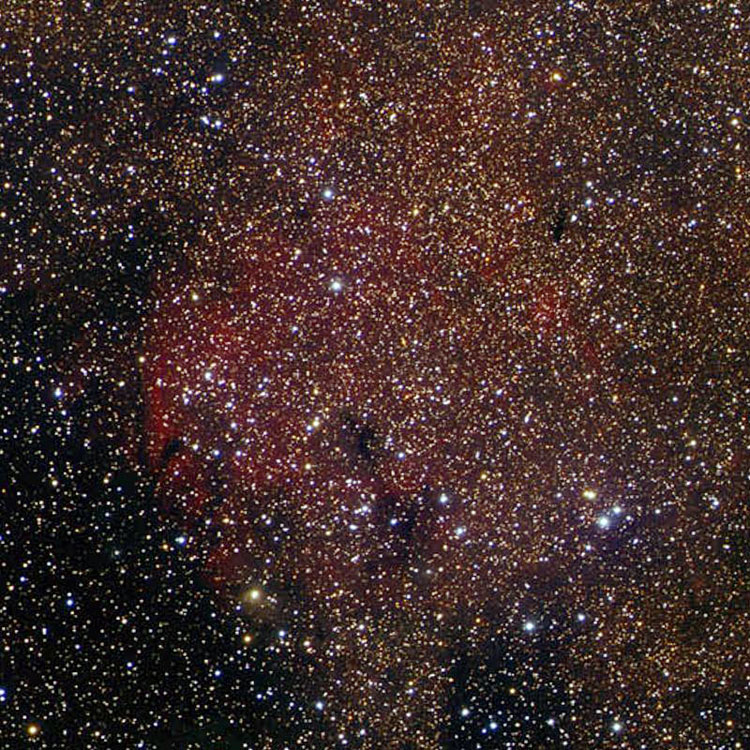
Above, a 1 degree wide image centered on IC 4701 (Wikisky cutout, origin unknown)
IC 4702 (= PGC 61810)
Discovered (Sep 14, 1901) by DeLisle Stewart
A magnitude 13.1 spiral galaxy (type SBa?) in Pavo (RA 18 23 03.7, Dec -59 14 20)
Historical Identification: Per Dreyer, IC 4702 (= DeLisle Stewart #460, 1860 RA 18 10 39, NPD 149 18) is "extremely faint, extremely small, star in disc, ring suspected". The position precesses to RA 18 23 03.2, Dec -59 14 34, right on the galaxy listed above, the description fits and there is nothing else nearby, so the identification is certain.
Physical Information: Apparent size 1.7 by 1.3 arcmin.
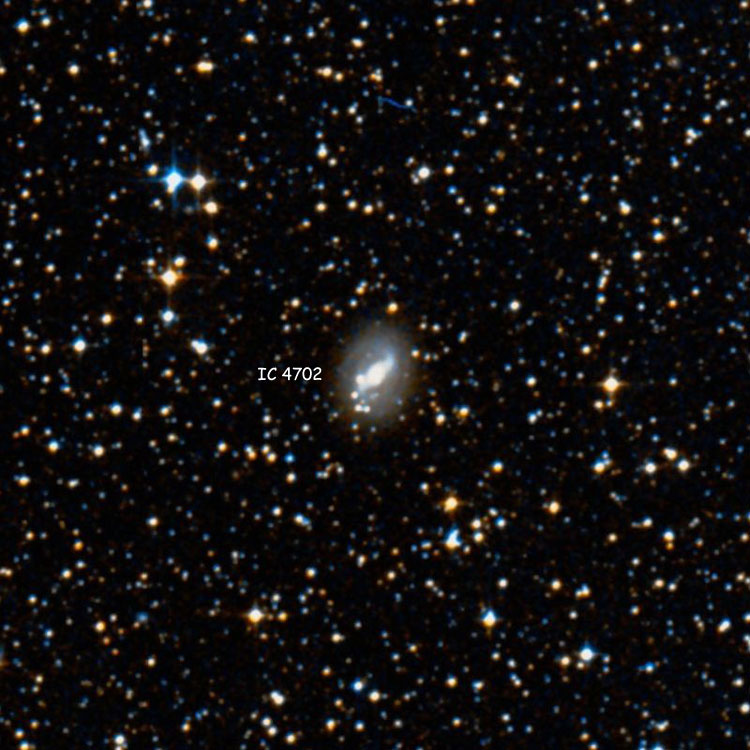
Above, a 12 arcmin wide DSS image centered on IC 4702
Below, a 2.2 arcmin wide DSS image of the galaxy

IC 4703 (= LBN 67), the Eagle Nebula
Discovered (Jun 3, 1764) by Charles Messier (and listed as M16)
Discovered (1876) by Etienne Trouvelot
Discovered (1894) by Isaac Roberts (and later listed as IC 4703)
An emission nebula associated with a star cluster (NGC 6611) in Serpens (RA 18 18 54, Dec -13 50 24)
Historical Identification: Per Dreyer, IC 4703 (= Roberts, 1860 RA 18 11, NPD 103 50) is "bright, extremely large, cluster M16 involved". The position precesses to RA 18 18 56.2, Dec -13 46 57, well within the brightest part of the nebula listed above, so the identification is certain.
Discovery Note: Although Roberts photographed the nebula in 1894, it had already been visually observed and described in detail by Trouvelot, who suggested a name (the Fan) that seems more appropriate than its commonly used name. Of course Messier had already discovered the "cluster of stars enmeshed in a faint glow" a century earlier, but as his description indicates, the cluster was more noticeable to him than the nebula (as is generally true in small visual telescopes, which favor stars over nebulae), so Dreyer treated M16 as being primarily the cluster itself, listed it as NGC 6611, and more or less needlessly added the IC entry for the nebula lit by the cluster.
Physical Information: The Eagle Nebula and the young star cluster associated with it are about 7000 light years away, meaning we see them as they were 7000 years ago. But to the left of the brightest part of the nebula (where the star cluster is centered) is a violently expanding cloud of gas caused by a supernova that took place about 6000 years ago. High-velocity gases thrown out by the supernova subsequently compressed and simultaneously tore apart the so-called "Pillars of Creation" near the center of the nebula (though we won't see that until a millennium from now). In the process, most of the clouds of gas and dust now visible here would be torn apart, but some of the denser nodules hidden inside the Pillars would be violently compressed to quickly form bright new stars. In fact, in such regions close to half the bright stars form as the result of such events, and for lower mass stars like our Sun, compression by gases pushed away from brighter stars is almost always the cause of their formation. The apparent size of the brighter inner region of IC 4703 is about 30 by 20 arcmin; of the entire nebula, about 70 by 40 arcmin. Given the estimated distance of the nebula, that corresponds to about 65 light years for the brighter inner region, and about 150 light years for the entire nebula.
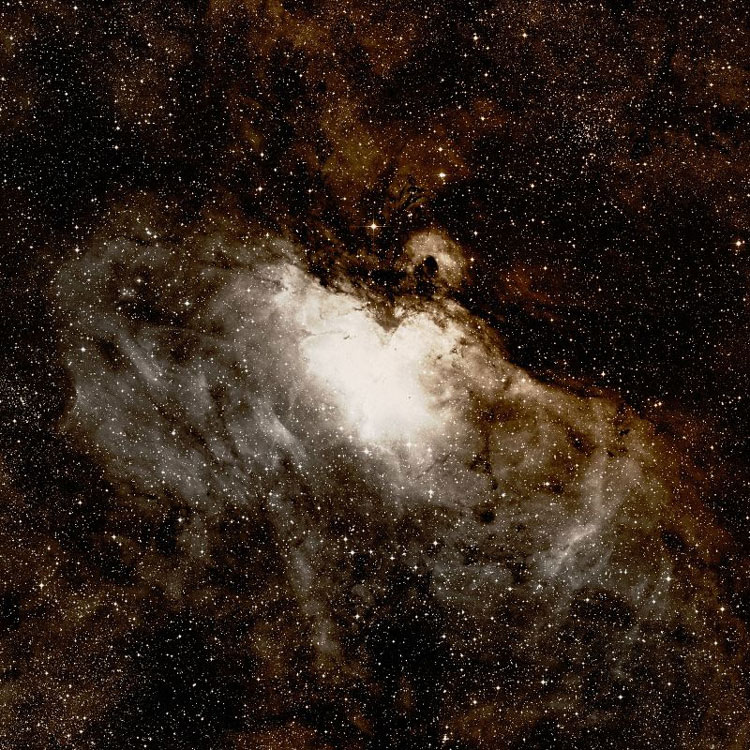
Above, a 90 arcmin wide DSS image centered on IC 4703
Below, a 43 arcmin NOAO image of the region near IC 4703 (Image Credits: Bill Schoening/NOAO/AURA/NSF)

Below, a 23 arcmin wide NOAO image of IC 4703 (Image Credits: Bill Schoening/NOAO/AURA/NSF)
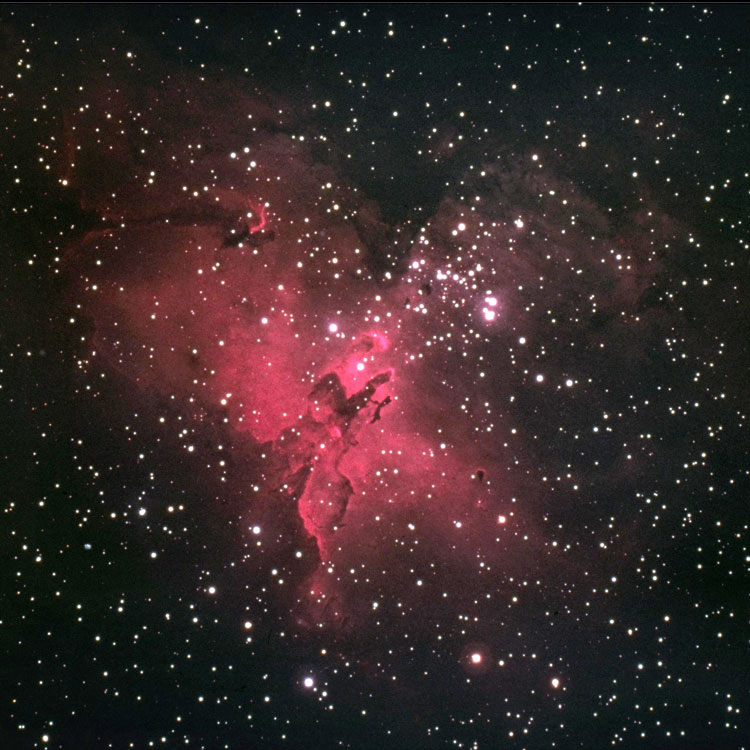
Below, a 26 arcmin wide NOAO multi-band image of the nebula (click here for a wider version)
(Image Credits: T.A.Rector (NRAO/AUI/NSF & NOAO/AURA/NSF) & B.A.Wolpa (AURA/NSF), NOAO)

Below, a 13 arcmin wide closeup of the image above
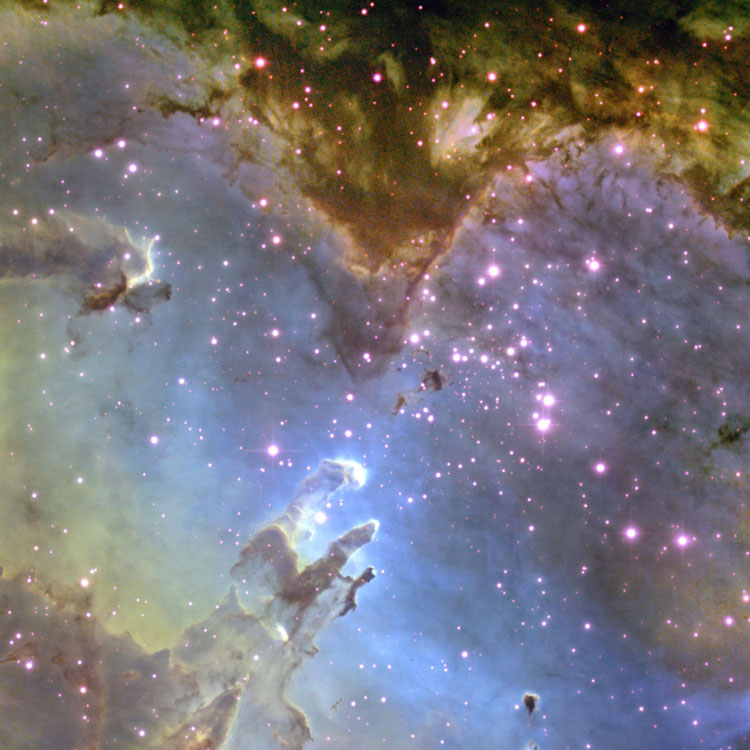
Below, a 2.6 arcmin wide HST view of the "Pillars of Creation"
(Image Credits: J. Hester, P. Scowen (ASU), HST, NASA)
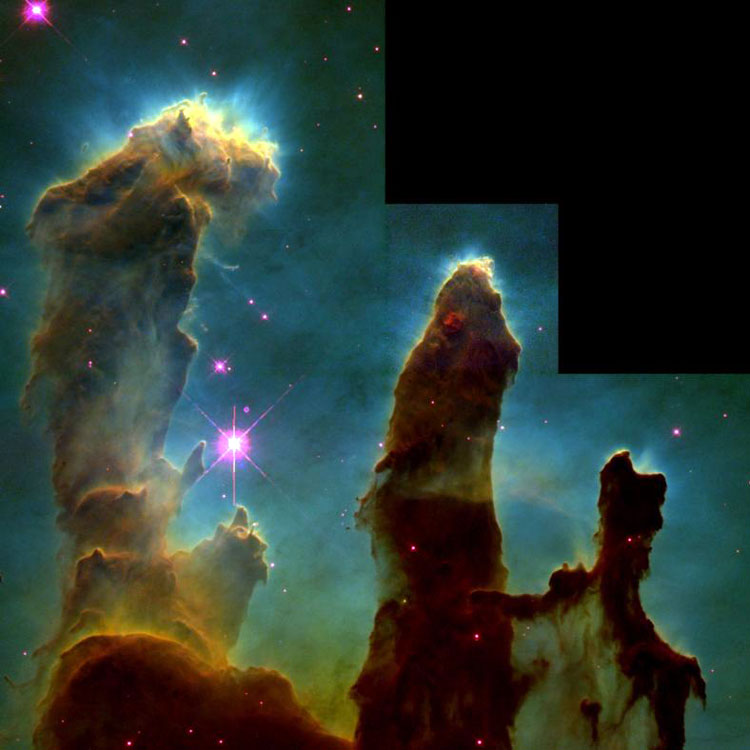
Below, a 2014 update of the image above shows how hot gases are eating away the 'pillars'
(Image Credit NASA/ESA/Hubble Heritage Team (STScI/AURA)/J. Hester, P. Scowen (Arizona State U.))
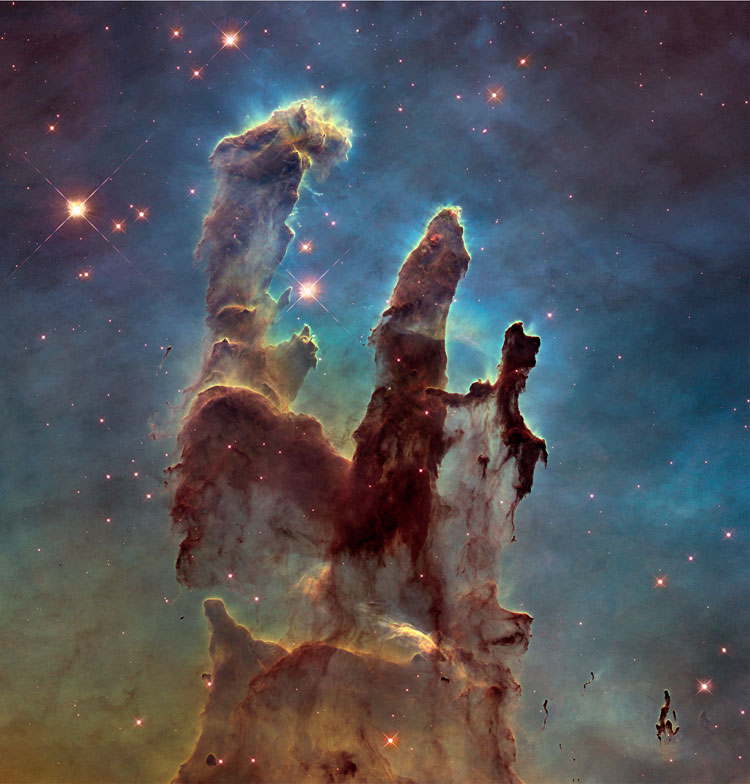
IC 4704 (= PGC 61906)
Discovered (Aug 20, 1900) by DeLisle Stewart
A magnitude 12.1 lenticular galaxy (type E/SA0?) in Pavo (RA 18 27 53.4, Dec -71 36 35)
Historical Identification: Per Dreyer, IC 4704 (= DeLisle Stewart #462, 1860 RA 18 11 16, NPD 161 40) is "considerably bright, brighter middle". The position precesses to RA 18 27 37.9, Dec -71 36 03, about 1.3 arcmin west northwest of the galaxy listed above, and the description fits, so the identification is certain.
Physical Information: Apparent size 3.2 by 2.2 arcmin.

Above, a 12 arcmin wide DSS image centered on IC 4704, also showing IC 4705
Below, a 3.5 arcmin wide DSS image of the galaxy

IC 4705 (= PGC 61914)
Discovered (Aug 20, 1900) by DeLisle Stewart
A magnitude 12.7 spiral galaxy (type SB(s)a? pec) in Pavo (RA 18 28 10.3, Dec -71 41 39)
Historical Identification: Per Dreyer, IC 4705 (= DeLisle Stewart #463, 1860 RA 18 11 27, NPD 161 45) is "extremely faint, extremely small, round". The position precesses to RA 18 28 01.5, Dec -71 40 59, less than an arcmin northwest of the galaxy listed above, and the description fits, so the identification is certain. (Although not necessary to confirm the identification, the relative positions of IC 4705 and its apparent neighbor, IC 4704, closely match Stewart's relative positions for them.)
Physical Information: This galaxy exhibits a very strange structure, with a long tail of material definitely stretching to the southwest, and apparently another to the south southeast. (Though I can't help wondering whether some of the "streaming" might be due to an unfortunate variation in the sensitivity of the blue plate, having such a variation so directly connected to the image of the galaxy would be an unusual coincidence, and I believe the features are more likely to be real than not, and feel that this is an object that cries out for closer examination.) The apparent size of the main galaxy is about 2.1 by 1.0 arcmin, while the streamers appear to extend at least 2 arcmin to the southeast, and 2.5 arcmin to the south southwest.

Above, a 12 arcmin wide DSS image centered on IC 4705, also showing IC 4704
Below, a 3.0 arcmin wide DSS image of the galaxy
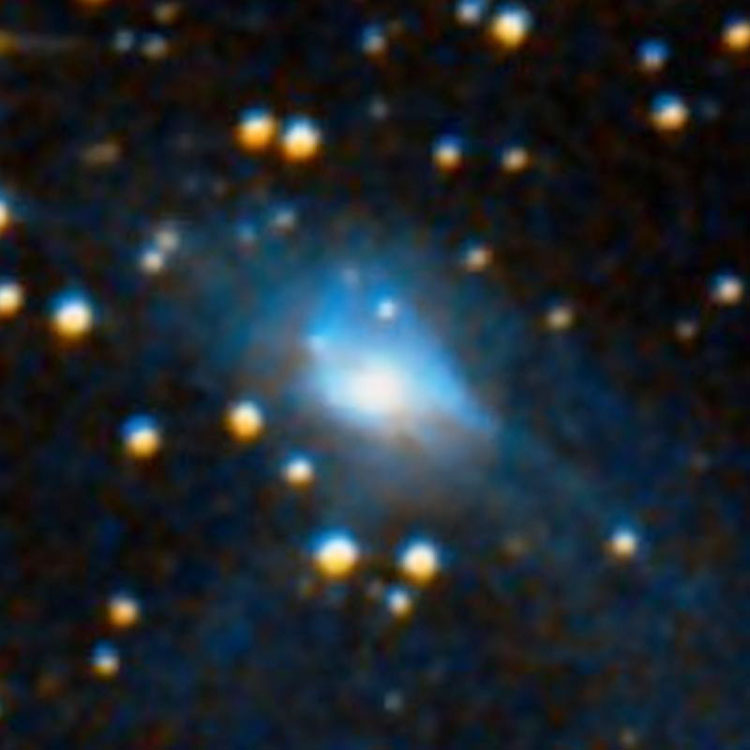
IC 4706 (= CED 160A)
Discovered (August 1905) by Edward Barnard
An emission nebula in Sagittarius (RA 18 19 37.7, Dec -16 00 51)
Historical Identification: Per Dreyer, IC 4706 (= Barnard (( A. N. 4239), 1860 RA 18 11 35, NPD 106 04.1) is a "9.2 magnitude star in small nebula (both this and IC 4707 are connected with M17)". The position precesses to RA 18 19 39.0, Dec -16 00 55, which happens to land on the nebula listed above, but that is more by chance than proper measurement. (The following is based on a note by Corwin, but is not stated in the same way, so the opinions expressed are mine, and any conflict with previous interpretations are therefore my responsibility as well.) The statement by Barnard that led to Dreyer's listing of IC 4706 and 4707 refers to a region near the Swan or Omega Nebula ( M17): "Preceding the brightest portion of the nebula, by about 15 arcmin, are two small stars involved in a small nebulosity. These stars are BD -16°4812 and -16°4813 of the 9.2 and 9.4 magnitudes, whose positions are..." What Dreyer did was take the position of the first star (precessed to the equinox of 1860) as the position for IC 4706, and that of the second star as the position for IC 4707. But the stars involved in the nebula are BD-16°4811 and 4812, not 4812 and 4813 (per Corwin, the proof of this is that 4813 is well to the east, in a region with no nebulosity at all). As it happens, both stars are in the same nebula, which should be called IC 4706, since one of the two stars in that nebula is the one Dreyer used to define IC 4706; and IC 4707 should be lost or nonexistent, since Barnard did not refer to another nebula, and there is none where the incorrect star is (however, see IC 4707 for more about that). Given the above, the position for IC 4706 should be the average position of the two stars in that nebula (whence the position listed above; the individual positions, for those who want them, are J2000 RA 18 19 36.0, Dec -16 00 32 for BD-16°4811, and RA 18 19 39.43, Dec -16 01 20.5 for BD-16°4812.)
Physical Information: Apparent size 5.0 by 4.5 arcmin.

Above, a 12 arcmin wide region centered on IC 4706, showing the stars that define its position
Below, a 6 arcmin wide DSS image of the nebula
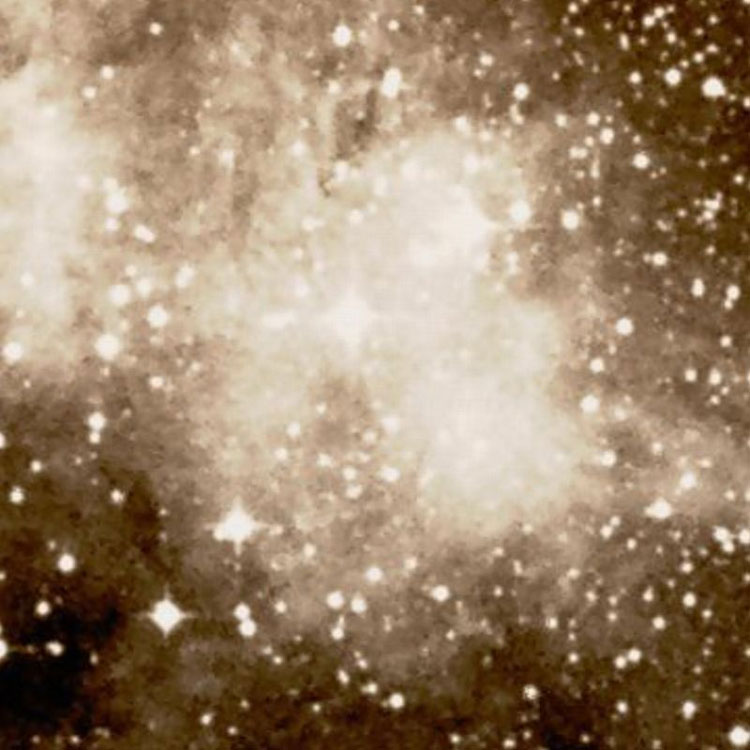
"IC 4707" (supposedly = CED 160B)
Recorded (August 1905) by Edward Barnard
A nonexistent object in Sagittarius (18 20 09.0, Dec -16 00 55)
or out of desperation, an emission nebula at RA 18 19 53.2, Dec -15 59 54
Historical Identification: Per Dreyer, IC 4707 (= Barnard (( A. N. 4239), 1860 RA 18 12 05, NPD 106 04.2) is a "9.4 magnitude star in small nebula (both this and IC 4706 are connected with M17)". The position precesses to RA 18 20 09.0, Dec -16 00 55 (whence the position for the nonexistent object above), which lands in a region to the east of any nebulosity. The reason for this, as discussed in the entry for IC 4706 (which see), is that Barnard misidentified the two stars that Dreyer used to define the IC entries for IC 4706 and 4707, and the actual stars observed by Barnard lie in the same nebula (IC 4706), and the one he thought he observed lies (as just stated) in a region obscured by absorption nebulae, so that there is no emission nebula at that location. However, since the IC2 defines two nebulae, one to the west and one to the east, and there happen to be two nebulae there (the actual IC 4706, and a non-NGC/IC nebula to its east), tradition has led to the eastern nebula being listed as IC 4707 (whence the position listed above for the emission nebula), even though it is not what Barnard actually observed.
Physical Information: Apparent size about 4.5 by 4.5 arcmin.
 Above, a 12 arcmin wide DSS image centered on the supposed IC 4707, showing that none of the stars used (whether correctly or erroneously) to define IC 4706 and 4707 have anything to do with the nebula, so that it is not really an NGC/IC object at all.
IC 4708 (= PGC 61605)
Discovered (Sep 11, 1899) by Herbert Howe
A magnitude 14.4 lenticular galaxy (type S0/a?) in Draco (RA 18 13 46.2, Dec +61 09 26)
Historical Identification: Per Dreyer, IC 4708 (= Howe list III (#21), 1860 RA 18 12 15, NPD 28 53.1) is "extremely faint, extremely small, very difficult, (NGC) 6617 near". The position precesses to RA 18 13 46.4, Dec +61 09 33, right on the galaxy listed above, and NGC 6617 is only 10 arcmin to the north, so the identification seems certain.
Physical Information: Apparent size 0.55 by 0.45 arcmin.
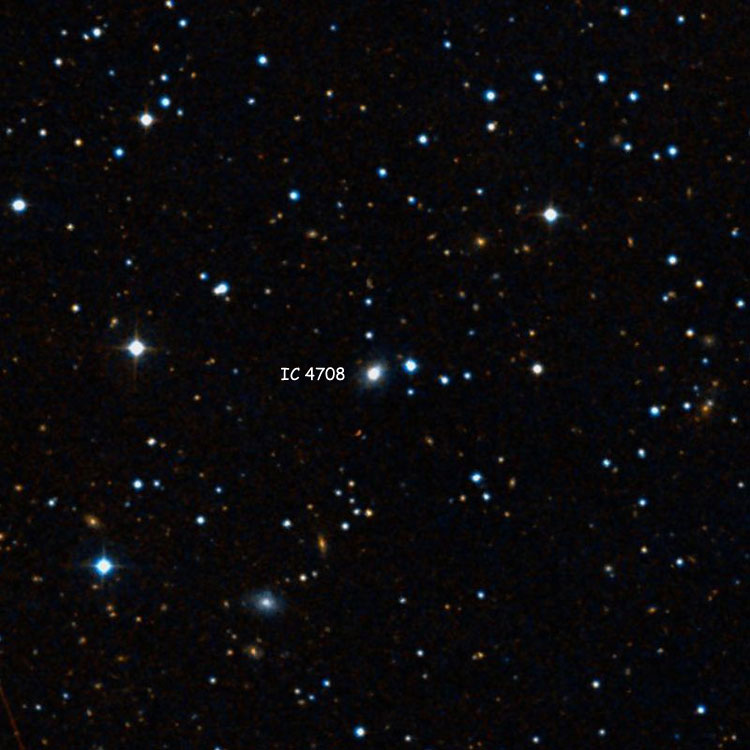
Above, a 12 arcmin wide DSS image centered on IC 4708
Below, a 0.8 arcmin wide DSS image of the galaxy
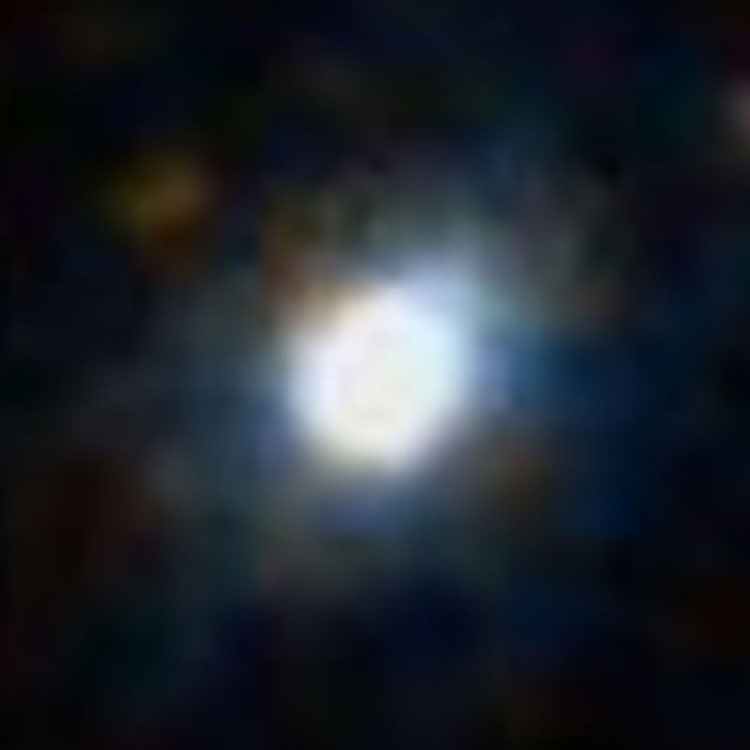
IC 4709 (= PGC 61835)
Discovered (Sep 14, 1901) by DeLisle Stewart
A magnitude 13.6 spiral galaxy (type (R)SB0(r)a?) in Telescopium (RA 18 24 19.3, Dec -56 22 07)
Historical Identification: Per Dreyer, IC 4709 (= DeLisle Stewart #461, 1860 RA 18 12 31, NPD 146 16) is "extremely faint, very small, very extended 0°, stellar nucleus; suspected". The position precesses to RA 18 24 20.3, Dec -56 12 15, but there is nothing there. However, exactly 10 arcmin due south (suggesting a simple 1-digit error by Stewart) there is a galaxy that perfectly fits the description (namely the one listed above), so there is little if any doubt about the certainty of the identification.
Physical Information: Apparent size 0.95 by 0.4 arcmin. A Seyfert galaxy? (type Sy 2, if so).

Above, a 12 arcmin wide DSS image centered on IC 4709
Below, a 1.2 arcmin wide DSS image of the galaxy

IC 4710 (= PGC 61922)
Discovered (Aug 18, 1900) by DeLisle Stewart
A magnitude 11.9 spiral galaxy (type SB(s)m?) in Pavo (RA 18 28 38.5, Dec -66 58 57)
Historical Identification: Per Dreyer, IC 4710 (= DeLisle Stewart #465, 1860 RA 18 14 09, NPD 157 03) is "very faint, very small, round, brighter middle". The position precesses to RA 18 28 38.5, Dec -66 58 38, right on the galaxy listed above, and there is nothing else nearby, so the identification is certain.
Physical Information: Based on a recessional velocity of 740 km/sec (and H0 = 70 km/sec/Mpc), IC 4710 is about 35 million light years away, in fair agreement with redshift-independent distance estimates of 25 to 30 million light years (the HST press release gives a distance of about 25 million light years). Given that and its apparent size of about 3.7 by 3.3 arcmin (from the images below), it is about 30 to 35 thousand light years across, indicating that it is a "dwarf" galaxy. Because new star formation is taking place throughout the galaxy it has an apparently chaotic structure; for this reason, some references list it as an irregular galaxy (type IBm).
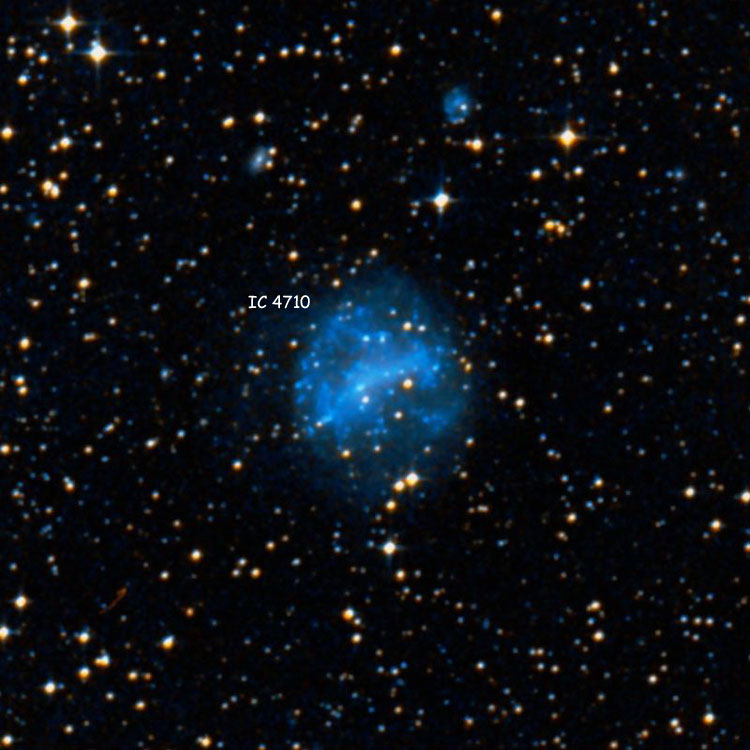
Above, a 12 arcmin wide DSS image centered on IC 4710
Below, a 4.0 arcmin wide DSS image of the galaxy
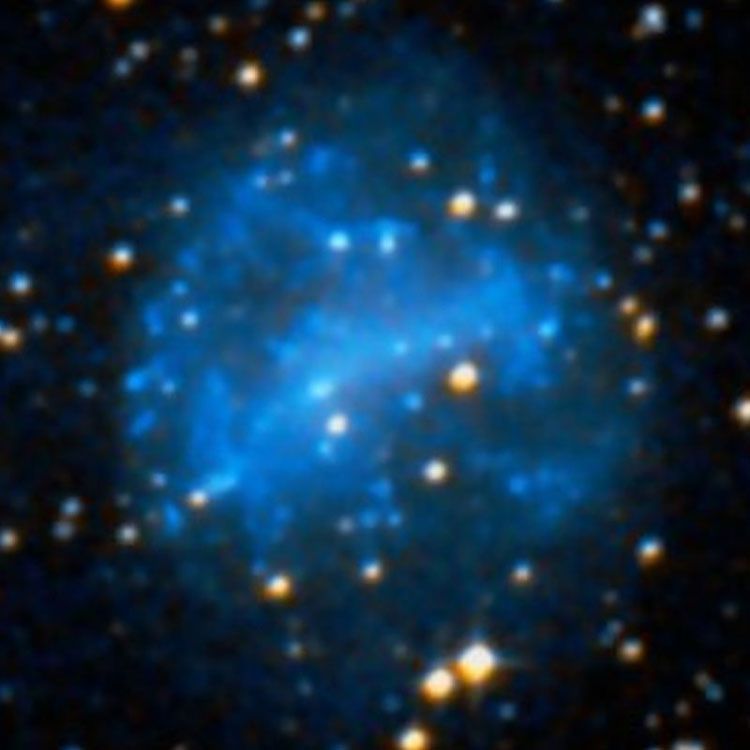
Below, a 3.7 arcmin wide image of the galaxy (Image Credits & © Carnegie-Irvine Galaxy Survey; used by permission)

Below, a 2.8 by 3.5 arcmin wide image of the galaxy
(Image Credit ESA/Hubble & NASA, Acknowledgements: Judy Schmidt)
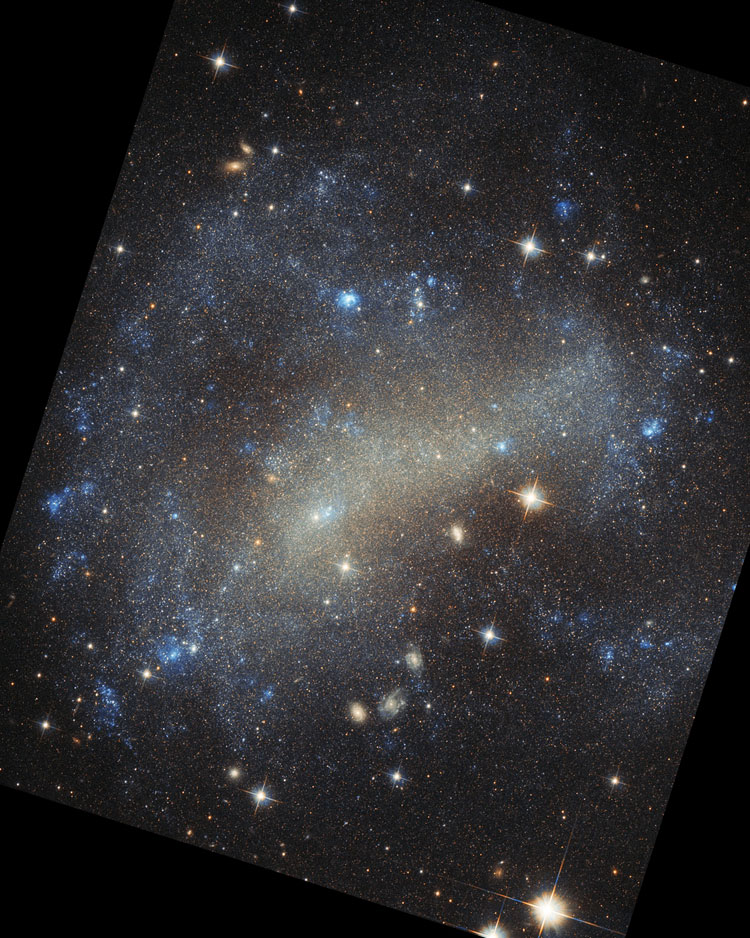
IC 4711
Recorded (Jul 20, 1901) by DeLisle Stewart
A line of three stars Pavo (RA 18 28 06.7, Dec -64 56 40)
Historical Identification: Per Dreyer, IC 4711 (= DeLisle Stewart #464, 1860 RA 18 14 15, NPD 155 01) is "extremely faint, extremely small, extremely extended 125°, stellar nucleus". The position precesses to RA 18 28 04.5, Dec -64 56 41, just south of the eastern star and just east of the middle star of three stars aligned at 130°, so the identification of the line of three stars listed above as Stewart's object is essentially certain, and the position shown for IC 4711 is for the middle star in the line. (Corwin suggests that there may also have been a plate defect involved, as Stewart's description states that the stellar nucleus was crossed by a nebulous line.)

Above, a 12 arcmin wide DSS image centered on IC 4711
IC 4712 (= PGC 61981)
Discovered (Aug 20, 1900) by DeLisle Stewart
A magnitude 12.2 spiral galaxy (type SA(rs)bc?) in Pavo (RA 18 31 06.7, Dec -71 41 38)
Historical Identification: Per Dreyer, IC 4712 (= DeLisle Stewart #466, 1860 RA 18 14 28, NPD 161 46) is "very faint, very small, round, brighter middle". The position precesses to RA 18 31 02.2, Dec -71 41 22, right on the galaxy listed above, so the identification is certain.
Physical Information: Apparent size 2.2 by 1.3 arcmin.
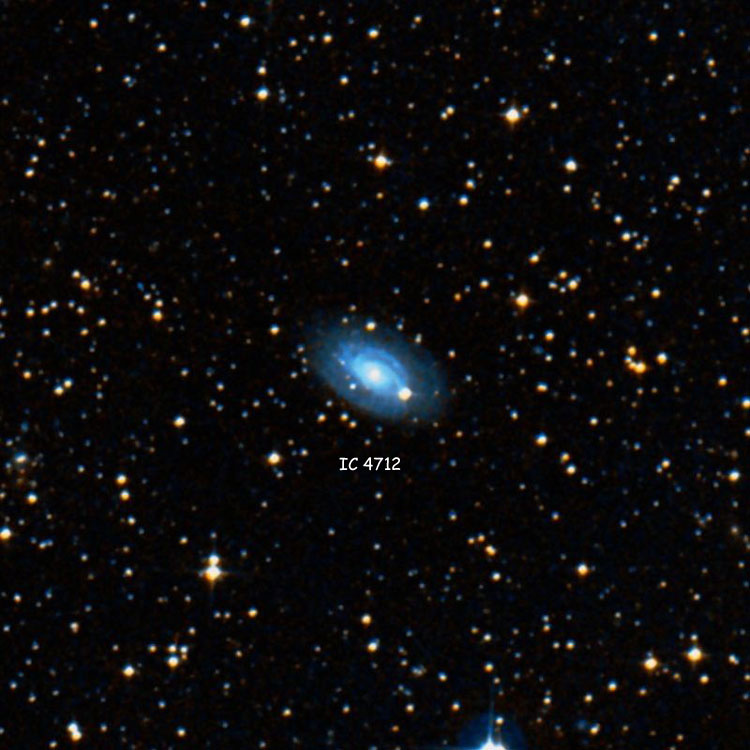
Above, a 12 arcmin wide DSS image centered on IC 4712
Below, a 2.4 arcmin wide DSS image of the galaxy
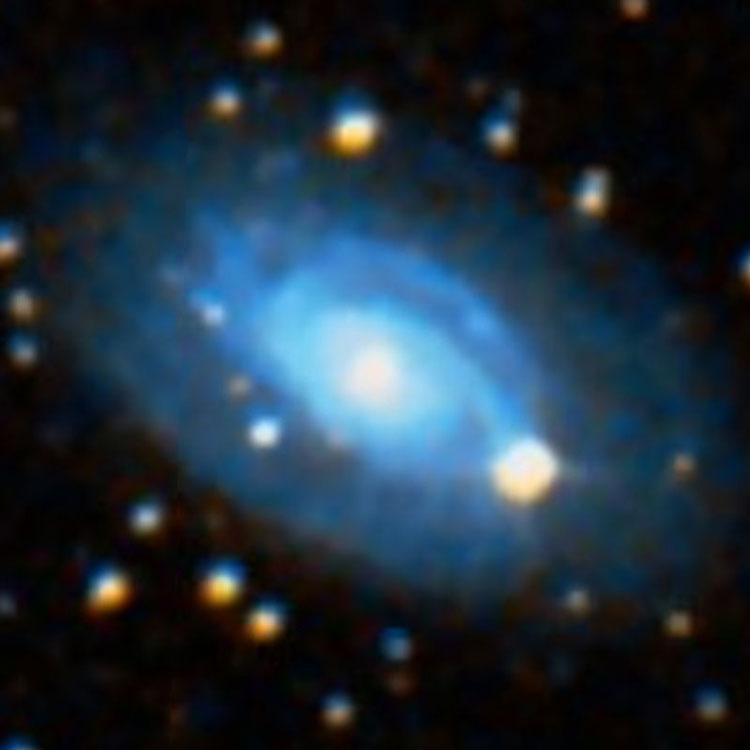
IC 4713 (= PGC 61956)
Discovered (Aug 18, 1900) by DeLisle Stewart
A magnitude 13.5 spiral galaxy (type SBcd?) in Pavo (RA 18 29 59.0, Dec -67 13 28)
Historical Identification: Per Dreyer, IC 4713 (= DeLisle Stewart #467, 1860 RA 18 15 20, NPD 157 18) is "very faint". The position precesses to RA 18 29 54.6, Dec -67 13 23, on the eastern outline of the galaxy listed above, and there is nothing else nearby, so the identification is certain. (Note: NED lists two galaxy types; the other is obviously a mis-transcription belonging to IC 4712.)
Physical Information: Apparent size 0.9 by 0.75 arcmin.
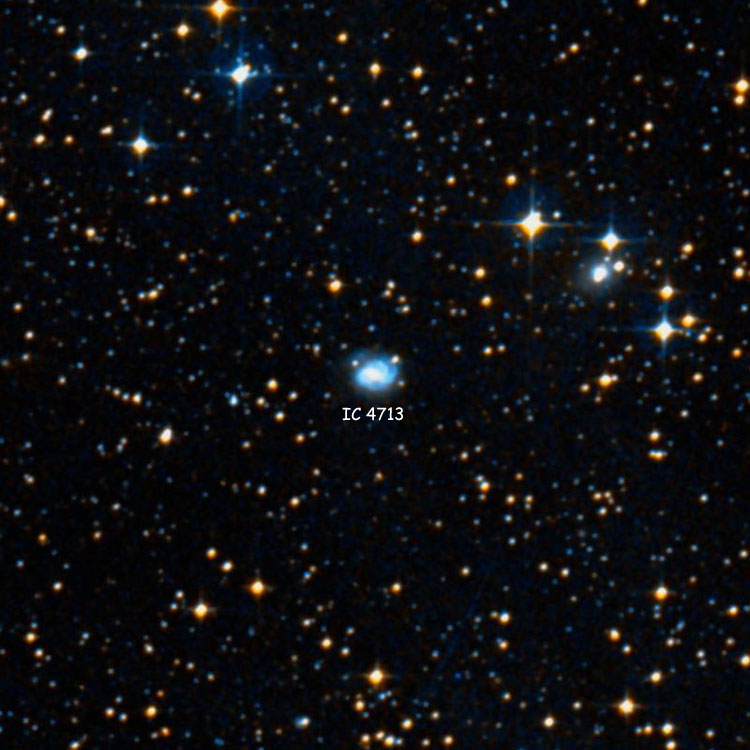
Above, a 12 arcmin wide DSS image centered on IC 4713
Below, a 1.2 arcmin wide DSS image of the galaxy
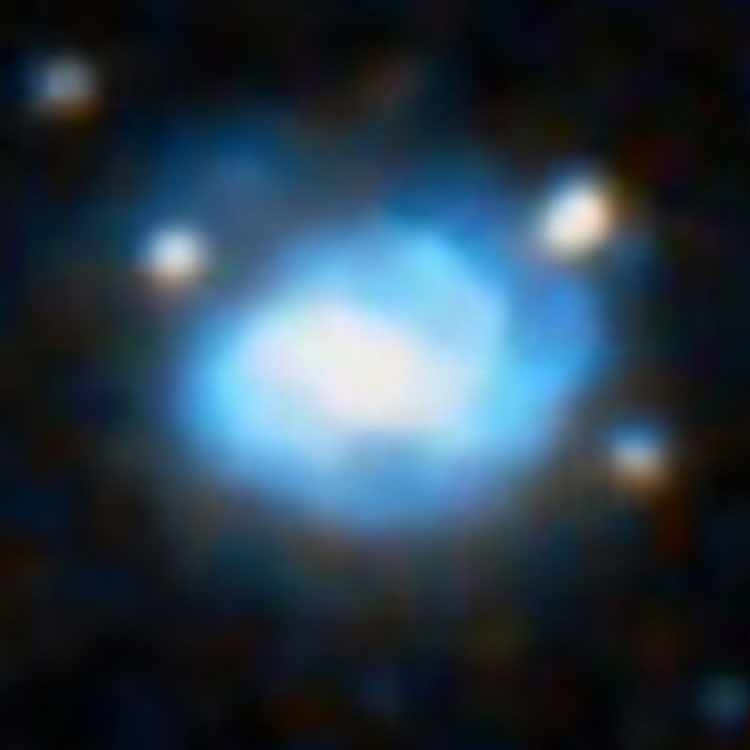
IC 4714 (= PGC 61976)
Discovered (Aug 18, 1900) by DeLisle Stewart
A magnitude 14.4 spiral galaxy (type Scd?) in Pavo (RA 18 30 55.7, Dec -66 39 06)
Historical Identification: Per Dreyer, IC 4714 (= DeLisle Stewart #468, 1860 RA 18 16 29, NPD 156 44) is "very faint". The position precesses to RA 18 30 51.3, Dec -66 39 11, less than half an arcmin west of the galaxy listed above, and there is nothing else nearby, so the identification is certain.
Physical Information: Apparent size 1.4 by 0.3 arcmin.
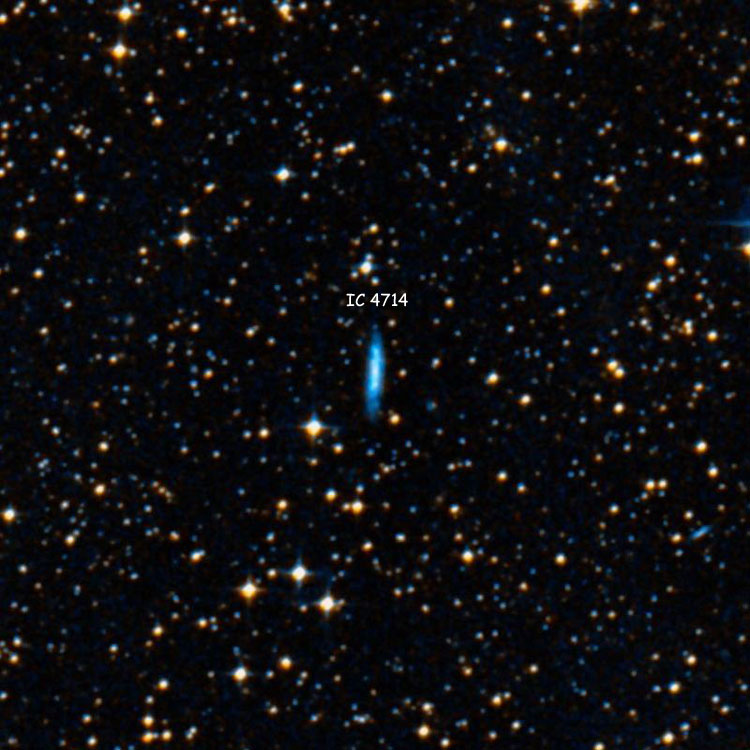
Above, a 12 arcmin wide DSS image centered on IC 4714
Below, a 1.8 arcmin wide DSS image of the galaxy
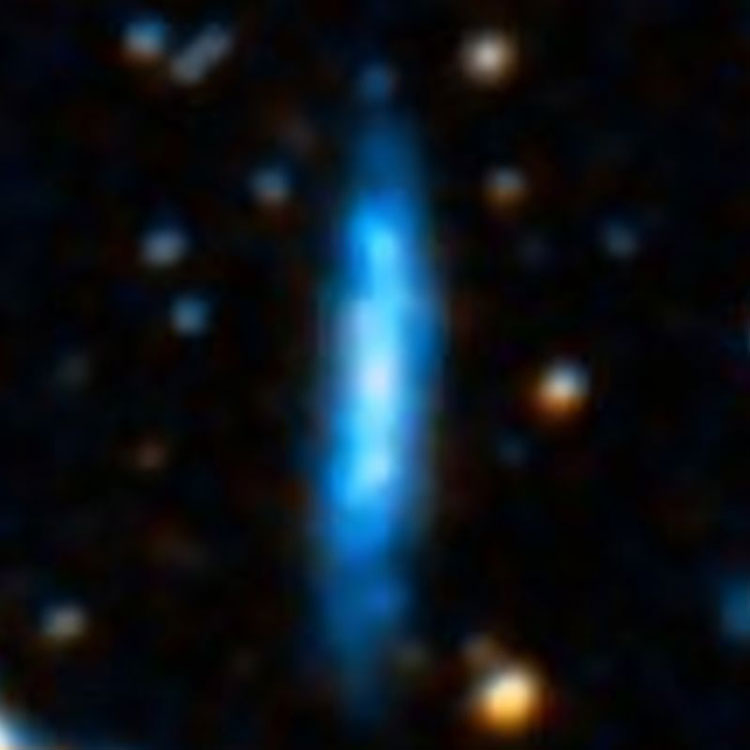
IC 4715 (= M24), the Sagittarius Star Cloud
Discovered (Jun 20, 1764) by Charles Messier (and listed as M24)
Discovered (August 1905?) by Edward Barnard (and later listed as IC 4715)
Star clouds in Sagittarius (RA 18 17, Dec -18 29)
Historical Identification: Per Dreyer, IC 4715 (= Barnard ((A. N. 4239), 1860 RA 18 18, NPD 108 30±) is a "most extremely large cloud of stars and nebulae". The position precesses to RA 18 26 12.5, Dec -18 25 30, in the middle of an endless sea of stars, but it is the wrong sea of stars, as Barnard listed the wrong right ascension, which should have been (1855) RA 18 08, not 18 18, and of course Dreyer used Barnard's (incorrect) position. The mistake can be detected by looking at Barnard's paper in A. N. 4239, which gives the appearance and (correct) positions of a number of dark nebulae that are near the star cloud, all of which have (1855) RA's between 18 07 and 18 09. However, the realization that there was a problem with the position of IC 4715 is very recent, having (per Corwin) being first noticed by Brent Archinal, then brought to Corwin's attention by Brian Skiff (in 2001). Using the correct (1800's) position, Barnard's object precesses to RA 18 16 12.7, Dec -18 27 32, very close to the position usually given for M24 (which is the position listed for the star cloud above), so the equality of the two designations is certain. However, since Dreyer had not previously given M24 an NGC/IC entry, this did not produce a double listing.
Discovery Note: Since Barnard's recorded position was well to the east of its correct position, the realization that it was the same object as M24 is relatively recent, so Messier's prior discovery of Barnard's object could not be recognized until that time.
Physical Information:
 Above, a 90 arcmin wide image of IC 4715 (= M24), also showing NGC 6603, which is sometimes misidentified as M24. (An earlier wider-field version of this image has been replaced because it didn't make clear what part of the image was M24.) (Image Credit: Fred Calvert/Adam Block/NOAO/AURA/NSF)
IC 4716 (= PGC 62013)
Discovered (Sep 14, 1901) by DeLisle Stewart
A magnitude 15.2 spiral galaxy (type SBc?) in Pavo (RA 18 32 45.0, Dec -56 57 43)
Historical Identification: Per Dreyer, IC 4716 (= DeLisle Stewart #469, 1860 RA 18 20 47, NPD 147 03) is "most extremely faint, extremely small, a little extended 90°, suspected". The position precesses to RA 18 32 43.5, Dec -56 57 33, on the northeastern rim of the galaxy listed above, the description fits, and there is nothing else nearby, so the identification is certain.
Physical Information: Apparent size 0.8 by 0.4 arcmin.
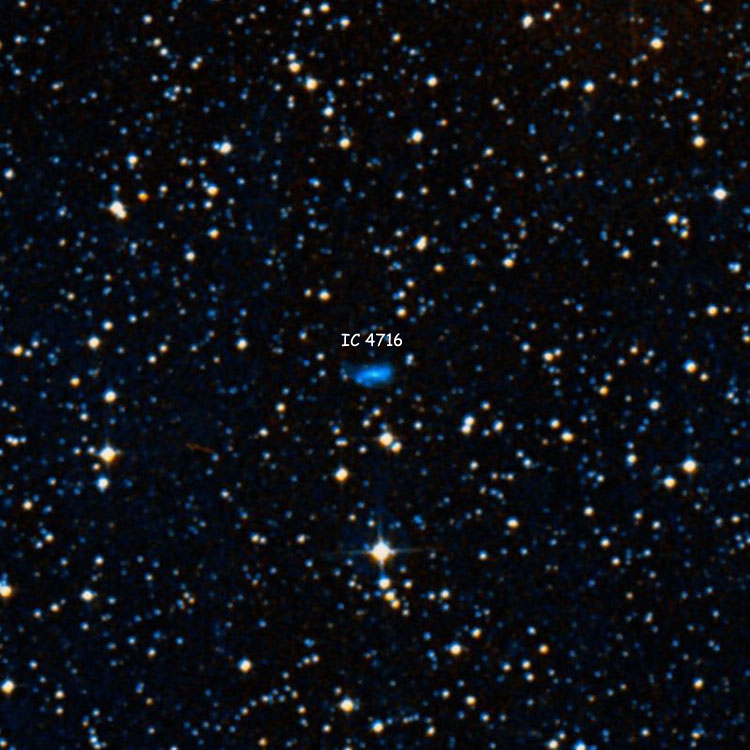
Above, a 12 arcmin wide DSS image centered on IC 4716
Below, a 1.0 arcmin wide DSS image of the galaxy

IC 4717 (= PGC 62024)
Discovered (Sep 14, 1901) by DeLisle Stewart
A magnitude 13.3 spiral galaxy (type Sb?) in Pavo (RA 18 33 17.1, Dec -57 58 31)
Historical Identification: Per Dreyer, IC 4717 (= DeLisle Stewart #470, 1860 RA 18 21 08, NPD 148 03) is "faint, small, extremely extended 95°, stellar nucleus". The position precesses to RA 18 33 15.7, Dec -57 57 28, just over an arcmin north of the galaxy listed above, the description fits, and there is nothing else nearby, so the identification is certain.
Physical Information: Apparent size 1.7 by 0.45 arcmin.
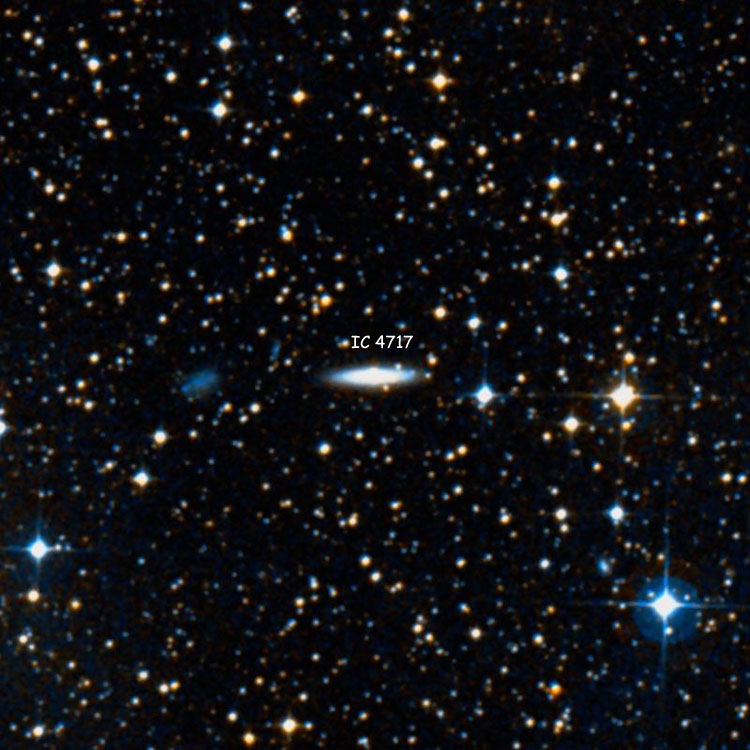
Above, a 12 arcmin wide DSS image centered on IC 4717
Below, a 2.0 arcmin wide DSS image of the galaxy
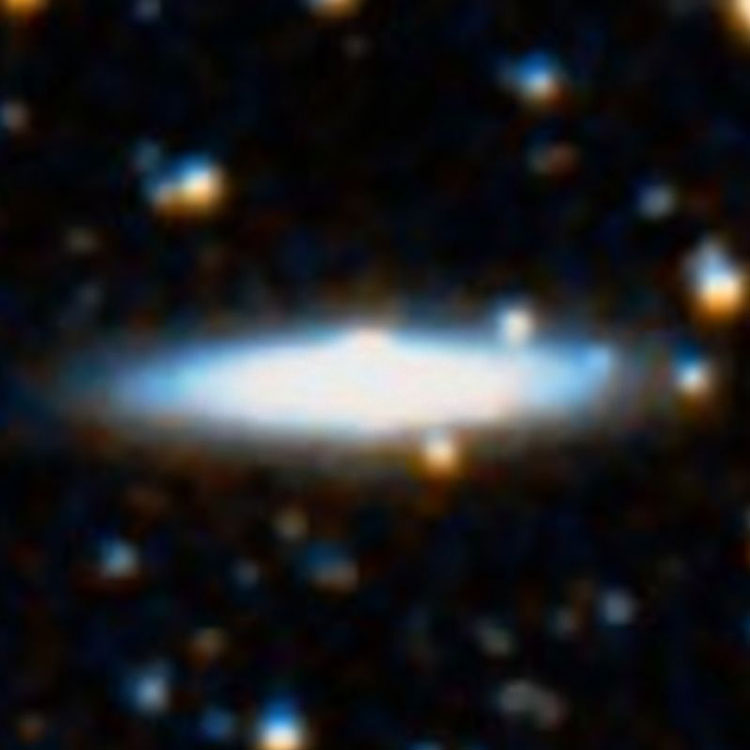
IC 4718 (= PGC 62048)
Discovered (Sep 14, 1901) by DeLisle Stewart
A magnitude 12.9 spiral galaxy (type Sb?) in Pavo (RA 18 33 50.0, Dec -60 07 45)
Historical Identification: Per Dreyer, IC 4718 (= DeLisle Stewart #473, 1860 RA 18 21 12, NPD 150 12) is "considerably bright, small, extended 125°, bright stellar nucleus". The position precesses to RA 18 33 46.1, Dec -60 06 24, about 1.4 arcmin north northwest of the galaxy listed above, but the description fits and there is nothing else nearby, so the identification is certain.
Physical Information: Apparent size 1.7 by 0.75 arcmin.

Above, a 12 arcmin wide DSS image centered on IC 4718
Below, a 2.0 arcmin wide DSS image of the galaxy
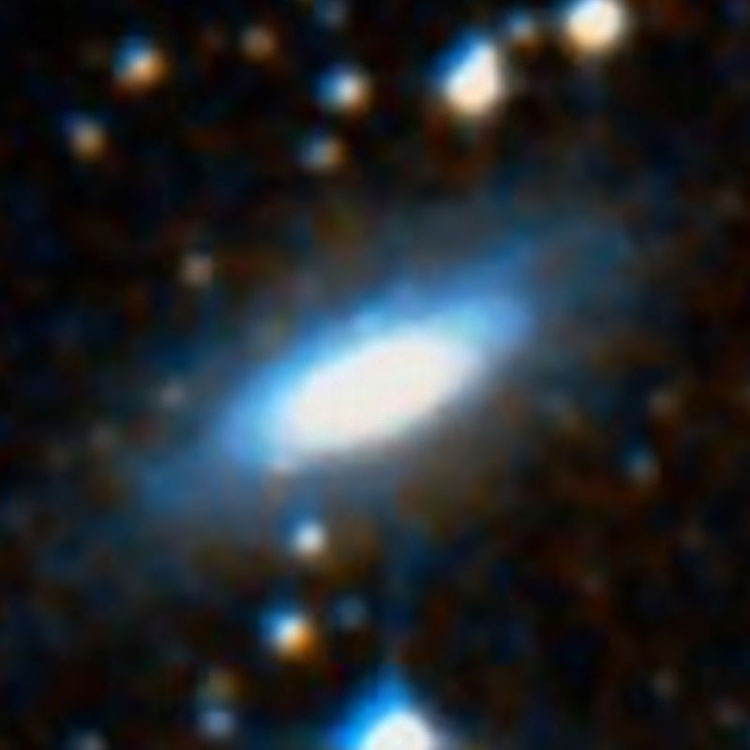
IC 4719 (= PGC 62022)
Discovered (Sep 14, 1901) by DeLisle Stewart
A magnitude 13.0 spiral galaxy (type SA(s)dm pec?) in Telescopium (RA 18 33 11.6, Dec -56 43 54)
Historical Identification: Per Dreyer, IC 4719 (= DeLisle Stewart #471, 1860 RA 18 21 18, NPD 146 49) is "extremely faint, very small, 2 patches, suspected". The position precesses to RA 18 33 11.9, Dec -56 43 27, almost on the northern rim of the galaxy listed above, and there is nothing else nearby, so the identification is certain.
Physical Information: Apparent size 1.5 by 0.95 arcmin.
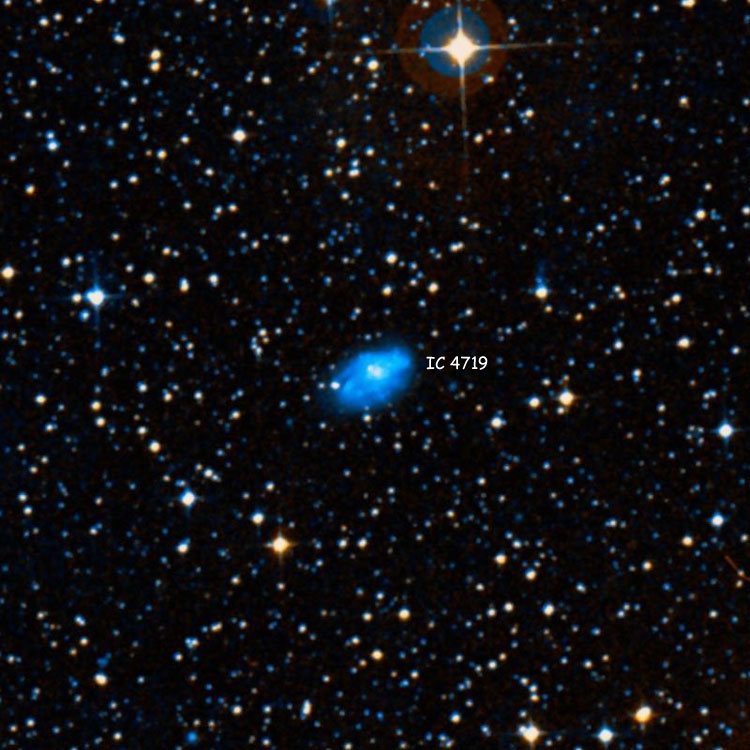
Above, a 12 arcmin wide DSS image centered on IC 4719
Below, a 1.8 arcmin wide DSS image of the galaxy

IC 4720 (= PGC 62030)
Discovered (Sep 14, 1901) by DeLisle Stewart
A magnitude 12.8 spiral galaxy (type SB(rs)cd?) in Pavo (RA 18 33 33.1, Dec -58 24 20)
Historical Identification: Per Dreyer, IC 4720 (= DeLisle Stewart #472, 1860 RA 18 21 18, NPD 148 29) is "considerably faint, small, extremely extended 165°, considerably brighter middle". The position precesses to RA 18 33 30.7, Dec -58 23 25, right on the galaxy listed above, and the description fits, so the identification is certain.
Physical Information: Apparent size 2.9 by 1.0 arcmin.
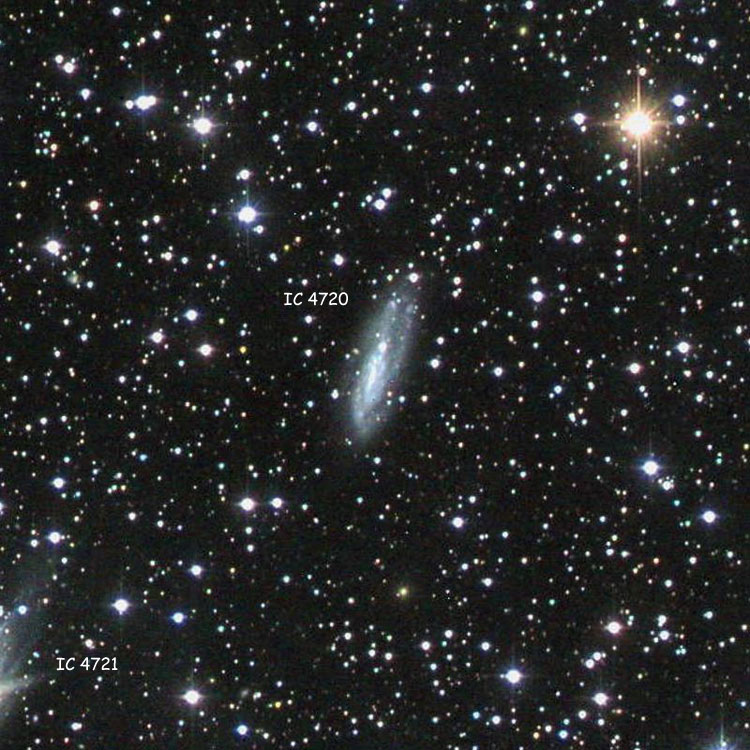
Above, a 12 arcmin wide Wikisky cutout centered on IC 4720, also showing part of IC 4721
(Image Credit above and below: Wikisky cutout of image uploaded by Jim Riffle)
Below, a 3.3 arcmin wide DSS image of the galaxy, merged with a Wikisky cutout to provide extra detail
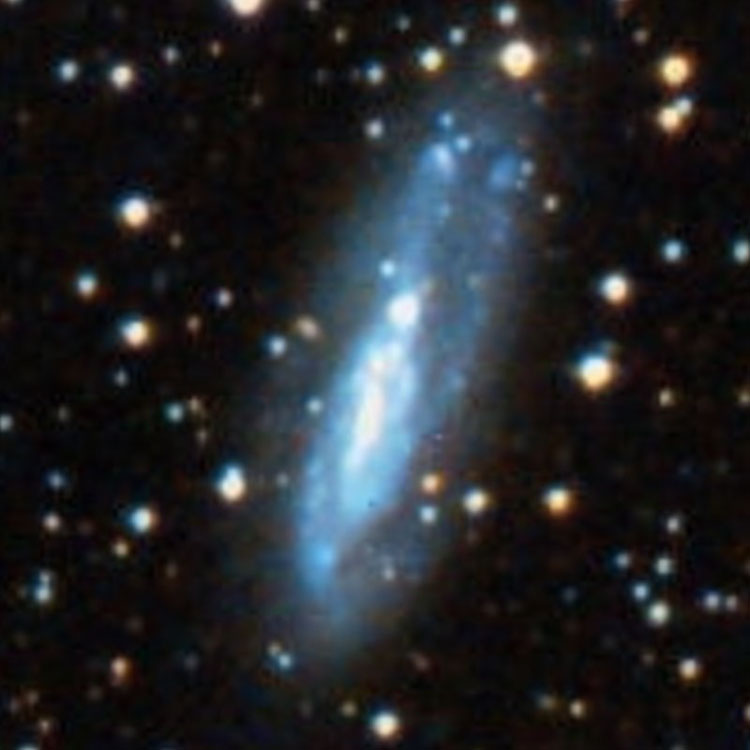
IC 4721 (= PGC 62066)
Discovered (Sep 14, 1901) by DeLisle Stewart
A magnitude 11.6 spiral galaxy (type SB(s)cd?) in Pavo (RA 18 34 25.0, Dec -58 29 50)
Historical Identification: Per Dreyer, IC 4721 (= DeLisle Stewart #474, 1860 RA 18 22 12, NPD 148 35) is "faint, considerably large, extended 150°". The position precesses to RA 18 34 25.7, Dec -58 29 14, right on the galaxy listed above and the description fits, so the identification is certain. However, per Corwin, since the galaxy sits in front of a background group, a distant spiral that lies behind the northwestern portion of IC 4721 looks like an oddly placed arm of the galaxy in front, and PGC 62063, an elliptical lying due south, is sometimes mistaken for IC 1721, and often called "IC 4721A".
Physical Information: Apparent size 5.6 by 1.6 arcmin.
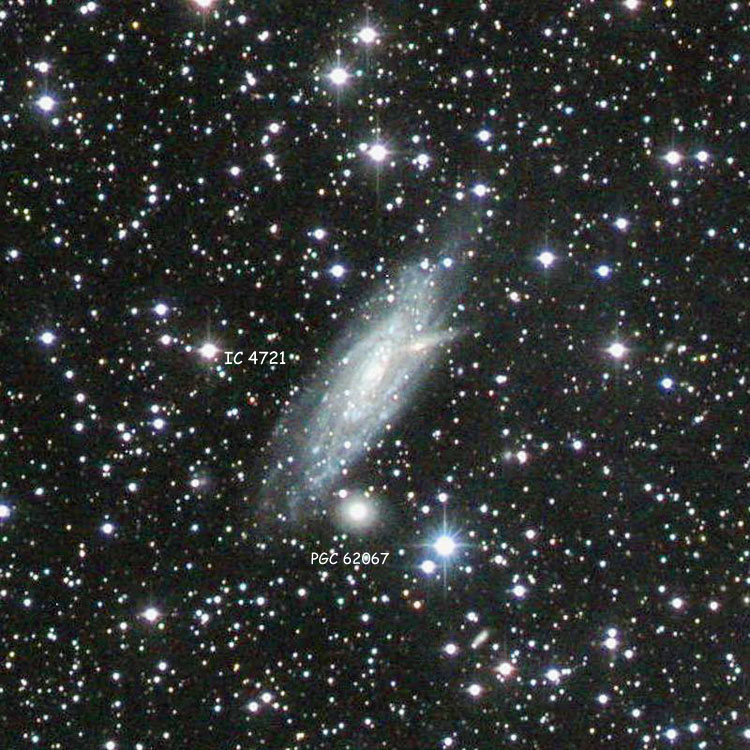
Above, a 12 arcmin wide Wikisky cutout centered on IC 4721, also showing PGC 62063
(Image Credit above and below: Wikisky cutout of image uploaded by Jim Riffle)
Below, a 5.5 arcmin wide DSS image of the galaxy, merged with a Wikisky cutout to provide extra detail
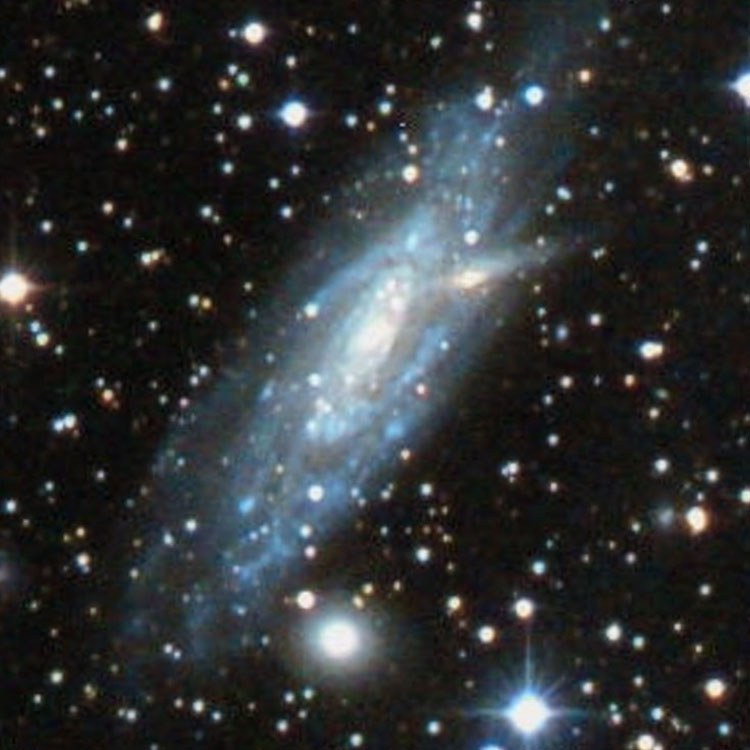
Below, a 5.5 arcmin wide image of the galaxy (Image Credit & © Carnegie-Irvine Galaxy Survey; used by permission)
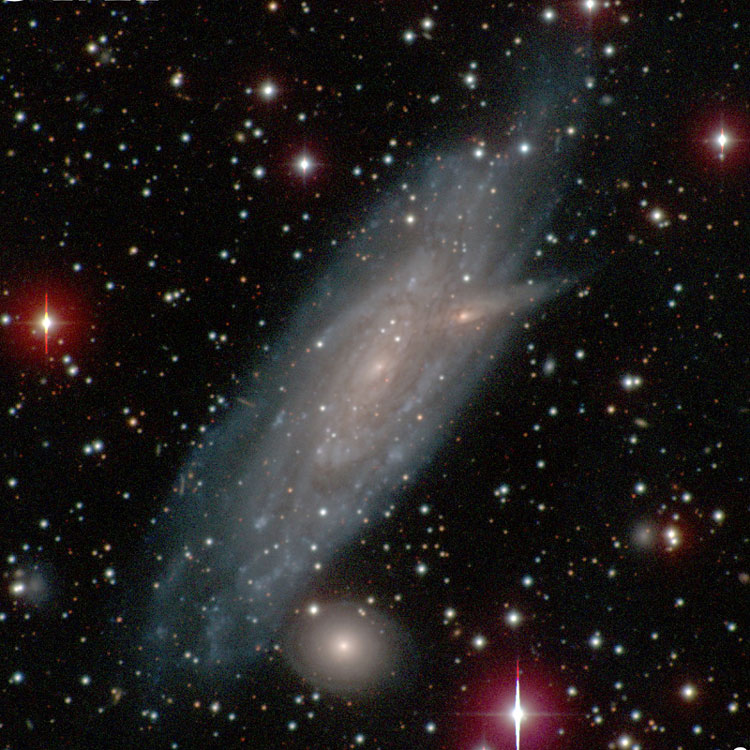
PGC 62063 (= PGC 62067= "IC 4721A")
Not an IC object but listed here since sometimes called IC 4721A due to proximity to IC 4721
A magnitude 13.5 elliptical galaxy (type E3?) in Pavo (RA 18 34 26.8, Dec -58 32 01)
Historical Identification: As noted in the entry for IC 4721, PGC 62063 is sometimes misidentified as that IC entry, and often called IC4721A.
Physical Information: Apparent size 1.1 by 0.8 arcmin.

Above, a 1.5 arcmin wide image of PGC 62063; see IC 4721 for a wide-field view
(Image Credit & © Carnegie-Irvine Galaxy Survey; used by permission)
IC 4722 (= PGC 62071)
Discovered (Sep 14, 1901) by DeLisle Stewart
A magnitude 12.8 spiral galaxy (type SA(s)bc pec?) in Pavo (RA 18 34 31.4, Dec -57 47 34)
Historical Identification: Per Dreyer, IC 4722 (= DeLisle Stewart #475, 1860 RA 18 22 26, NPD 147 52) is "faint, very small, 2 branch spiral". The position precesses to RA 18 34 31.3, Dec -57 46 12, about 1.3 arcmin north of the galaxy listed above, but there is nothing else nearby, so the identification is certain.
Physical Information: Apparent size 1.8 by 1.2 arcmin.
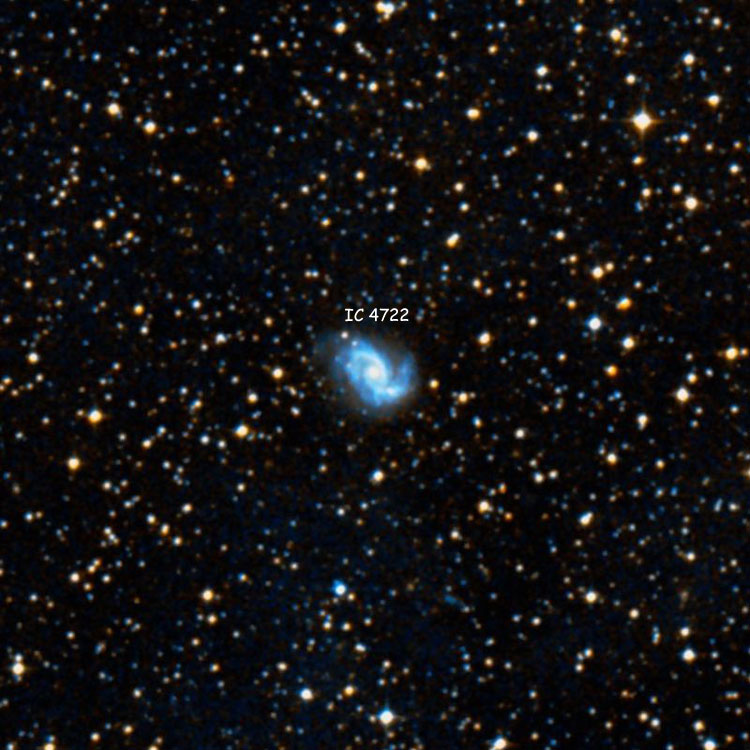
Above, a 12 arcmin wide DSS image centered on IC 4722
Below, a 1.8 arcmin wide DSS image of the galaxy

IC 4723 (= PGC 62099)
Discovered (Jul 20, 1901) by DeLisle Stewart
A magnitude 13.5 lenticular galaxy (type S0/a pec?) in Pavo (RA 18 35 56.0, Dec -63 22 37)
Historical Identification: Per Dreyer, IC 4723 (= DeLisle Stewart #476, 1860 RA 18 22 28, NPD 153 28) is "very faint, very small, round". The position precesses to RA 18 35 49.2, Dec -63 22 04, less than an arcmin northwest of the galaxy listed above, and there is nothing else nearby, so the identification is certain. (Though per Thomson, due to its small size, some references misidentify the galaxy as a planetary nebula.)
Physical Information: Apparent size 0.6 by 0.6 arcmin.

Above, a 12 arcmin wide DSS image centered on IC 4723
Below, a 0.8 arcmin wide DSS image of the galaxy

IC 4724 (= PGC 62183)
Discovered (Aug 27, 1900) by DeLisle Stewart
A magnitude 14.3 spiral galaxy (type Sc?) in Pavo (RA 18 38 40.3, Dec -70 07 31)
Historical Identification: Per Dreyer, IC 4724 (= DeLisle Stewart #477, 1860 RA 18 22 54, NPD 160 13) is "extremely faint, extremely small, considerably extended 170°". The position precesses to RA 18 38 38.3, Dec -70 06 44, about 0.8 arcmin north of the galaxy listed above, the description fits, and there is nothing else nearby, so the identification is certain.
Physical Information: Apparent size 0.85 by 0.45 arcmin.
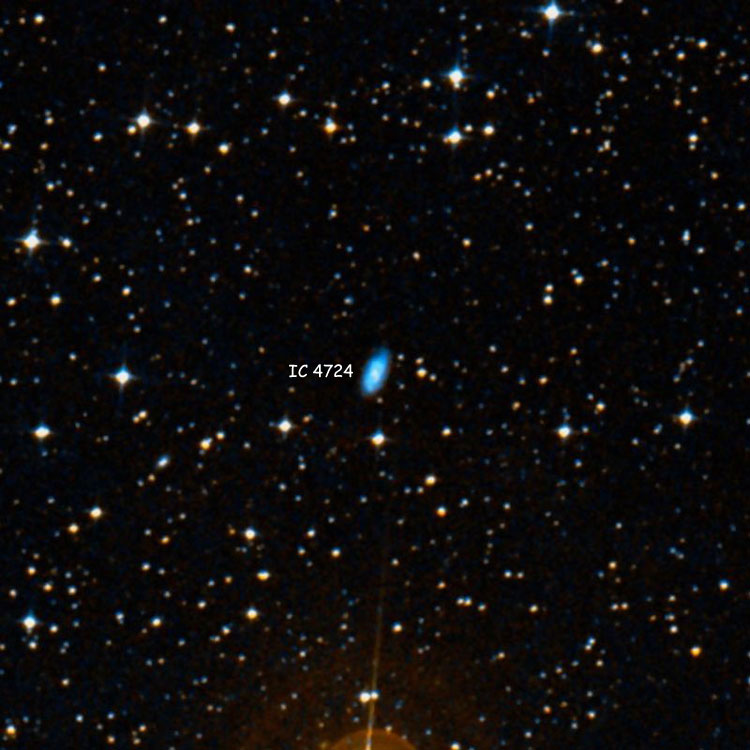
Above, a 12 arcmin wide DSS image centered on IC 4724
Below, a 1.0 arcmin wide DSS image of the galaxy
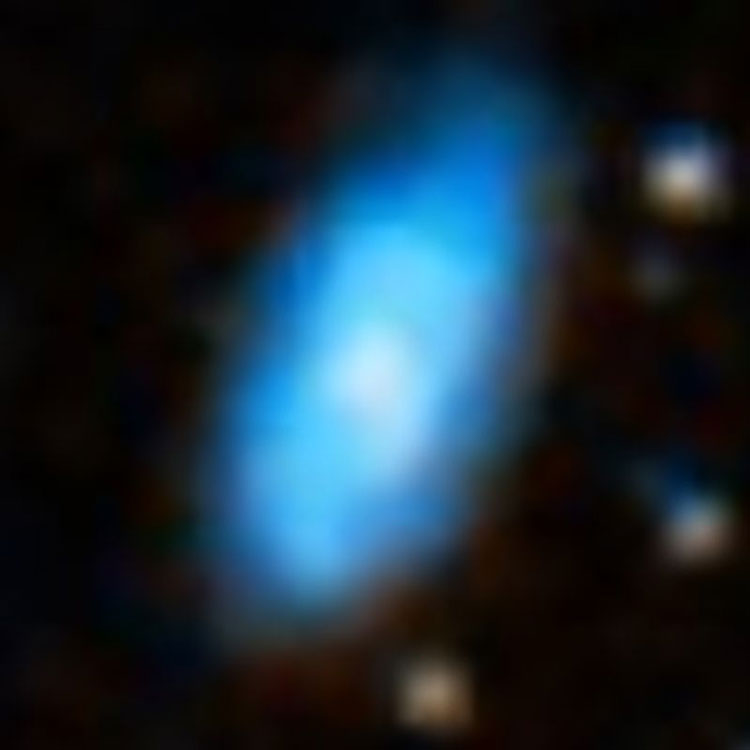
IC 4725 (= OCL 38 = M25)
Discovered (1745) by Philippe de Chéseaux
Discovered (June 20, 1764) by Charles Messier (and listed as M25)
Discovered (1896) by Solon Bailey (and later listed as IC 4725)
A magnitude 4.6 open cluster (type I2p) in Sagittarius (RA 18 31 45.0, Dec -19 07 12)
Historical Identification: Per Dreyer, IC 4725 (= M25, Bailey, 1860 RA 18 23 26, NPD 109 20) is a "cluster, pretty compressed". The position precesses to RA 18 31 41.3, Dec -19 14 23, several arcmin south of the core of the cluster but well within its outline, so the identification is reasonably certain. (Per Corwin, since Bailey did not realize that he was observing M25, what he observed may not have been the actual cluster, but merely a part of its outer extension or "halo"; however, rather than assign the IC entry to only a part of M25, tradition assigns it to the entire cluster.)
Discovery Note: As noted in the entry for de Chéseaux, his observations were essentially lost for nearly 150 years, so Messier's observation would have been the earliest known to Dreyer. Early on, Dreyer probably felt it was not necessary to include objects such as M25 in the NGC/IC, since they were so well known; but by the time Bailey published his list of about 300 clusters and nebulae in 1908, Dreyer must have had a change of heart, as he added all of Bailey's objects that were not in the NGC or IC1 to the IC2, save for the Hyades and Pleiades. (Perhaps the fact that Bailey didn't realize that this was M25 convinced Dreyer that it might be a good idea to include those Messier objects not yet in the catalog, to try to prevent similar future oversights.)
Physical Information: Apparent size 26 arcmin? A Hubble Legacy Archive image of the central star, HD 170764, suggests that it may be ejecting material, and may therefore be near the end of its life.
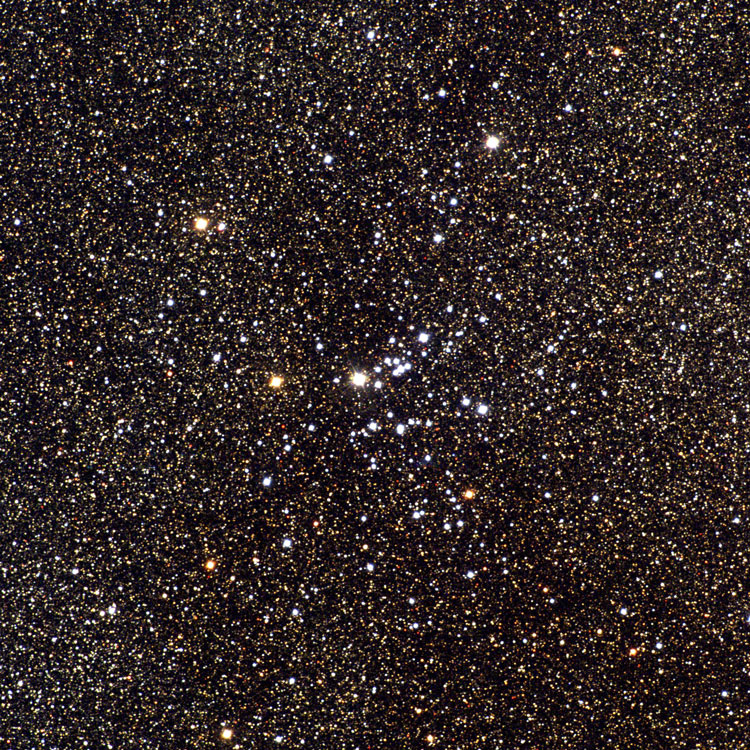
Above, a 30 arcmin wide image centered on M25
(Image Credits: Hillary Mathis, Vanessa Harvey, REU program/NOAO/AURA/NSF)
Below, a 26 arcmin wide image of the cluster (with North about 3 degrees left of up)
(Image Credits & © J. C. Cuillandre (CFHT) & Giovanni Anselmi (Coelum Astronomia), Hawaiian Starlight; used by permission)

IC 4726 (= PGC 62133)
Discovered (Jul 20, 1901) by DeLisle Stewart
A magnitude 13.4 lenticular galaxy (type S0?) in Pavo (RA 18 36 58.7, Dec -62 51 15)
Historical Identification: Per Dreyer, IC 4726 (= DeLisle Stewart #478, 1860 RA 18 23 43, NPD 152 57) is "extremely faint, very small, round, considerably faint star 0.5 arcmin northeast". The position precesses to RA 18 36 55.7, Dec -62 50 50, on the northwestern outline of the galaxy listed above, and the star to the northeast makes the identification certain.
Physical Information: Apparent size 1.25 by 0.9 arcmin.
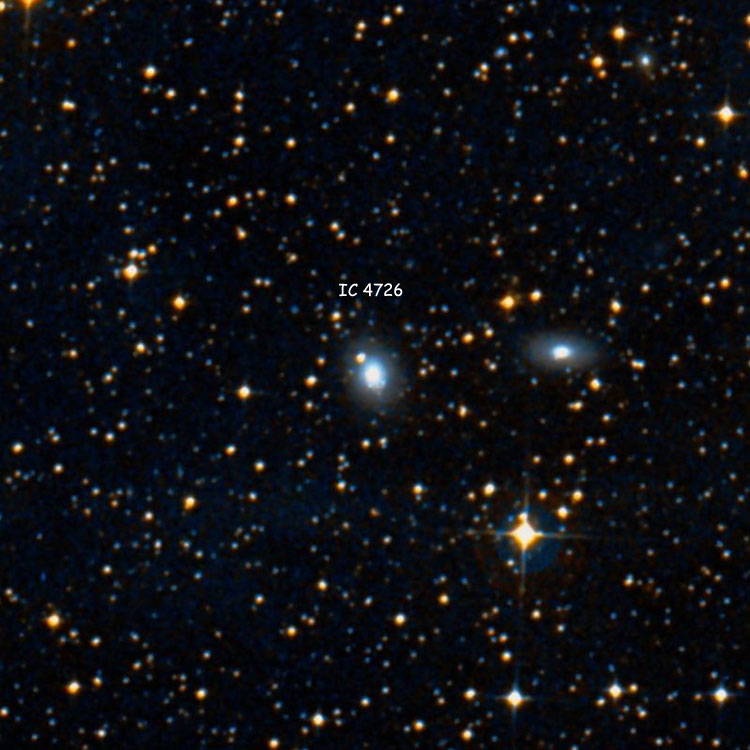
Above, a 12 arcmin wide DSS image centered on IC 4726
Below, a 1.5 arcmin wide DSS image of the galaxy
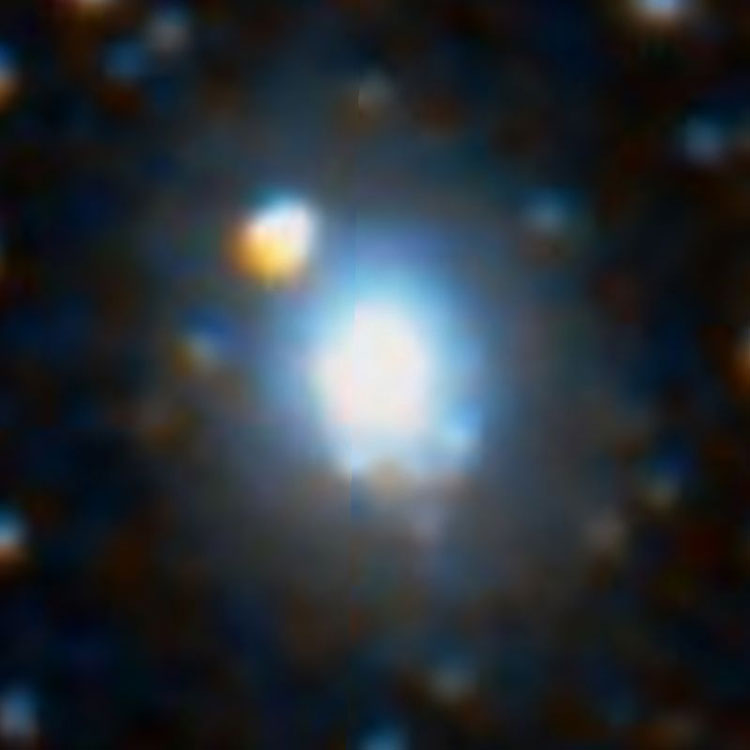
IC 4727 (= PGC 62165)
Discovered (Jul 20, 1901) by DeLisle Stewart
A magnitude 12.8 lenticular galaxy (type E/S0?) in Pavo (RA 18 37 55.8, Dec -62 42 01)
Historical Identification: Per Dreyer, IC 4727 (= DeLisle Stewart #479, 1860 RA 18 24 38, NPD 152 48) is "very faint, extremely small, round". The position precesses to RA 18 37 48.2, Dec -62 41 39, less than an arcmin northwest of the galaxy listed above, and there is nothing else nearby, so the identification is certain.
Physical Information: Apparent size 1.7 by 1.5 arcmin.

Above, a 12 arcmin wide DSS image centered on IC 4727
Below, a 2.0 arcmin wide DSS image of the galaxy
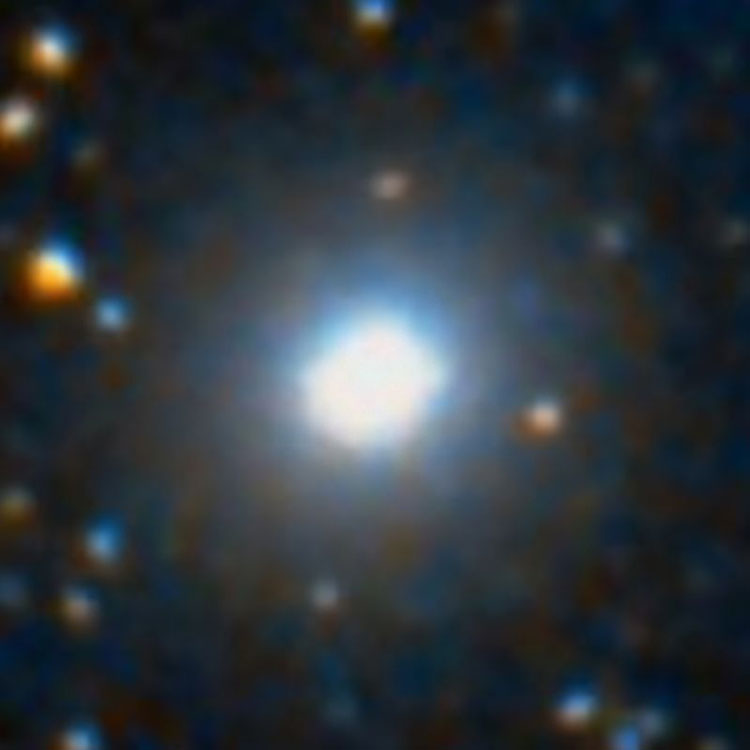
IC 4728 (= PGC 62166)
Discovered (Jul 20, 1901) by DeLisle Stewart
A magnitude 12.9 spiral galaxy (type SB(rs)ab?) in Pavo (RA 18 37 57.0, Dec -62 31 51)
Historical Identification: Per Dreyer, IC 4728 (= DeLisle Stewart #480, 1860 RA 18 24 45, NPD 152 38) is "extremely faint, small, considerably extended 170°, stellar nucleus". The position precesses to RA 18 37 52.6, Dec -62 31 38, barely outside the western rim of the galaxy listed above, the description fits, and there is nothing else nearby, so the identification is certain.
Physical Information: Apparent size 2.1 by 0.75 arcmin.

Above, a 12 arcmin wide DSS image centered on IC 4728
Below, a 2.4 arcmin wide DSS image of the galaxy
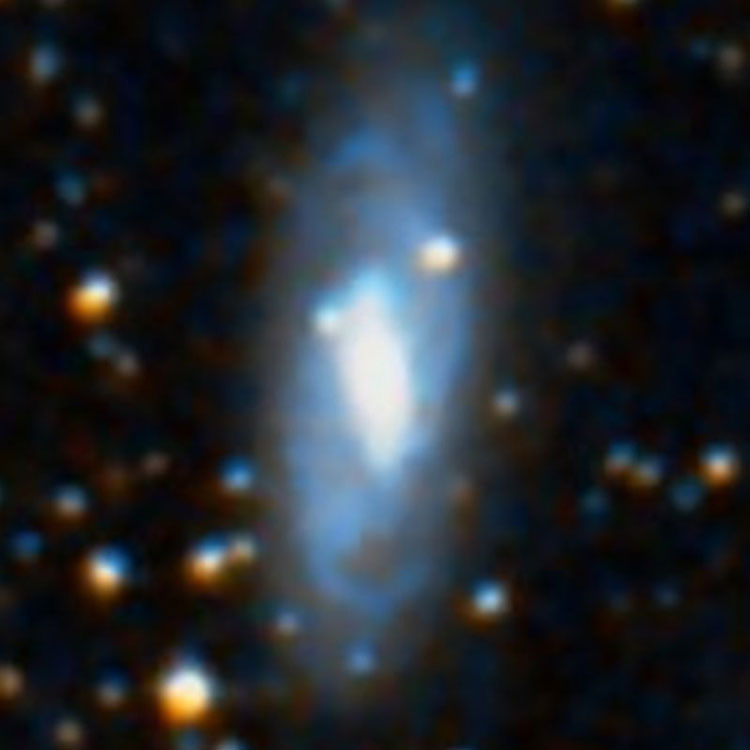
IC 4729 (= PGC 62218)
Discovered (Aug 27, 1900) by DeLisle Stewart
A magnitude 12.6 spiral galaxy (type SAB(r)c?) in Pavo (RA 18 39 56.3, Dec -67 25 32)
Historical Identification: Per Dreyer, IC 4729 (= DeLisle Stewart #483, 1860 RA 18 25 19, NPD 157 32) is "very faint, small, round, stellar nucleus". The position precesses to RA 18 39 56.0, Dec -67 25 22, right on the galaxy listed above, so the identification is certain.
Physical Information: Apparent size 1.5 by 1.2 arcmin. A Seyfert galaxy (type Sy 2).

Above, a 12 arcmin wide DSS image centered on IC 4729
Below, a 1.8 arcmin wide DSS image of the galaxy
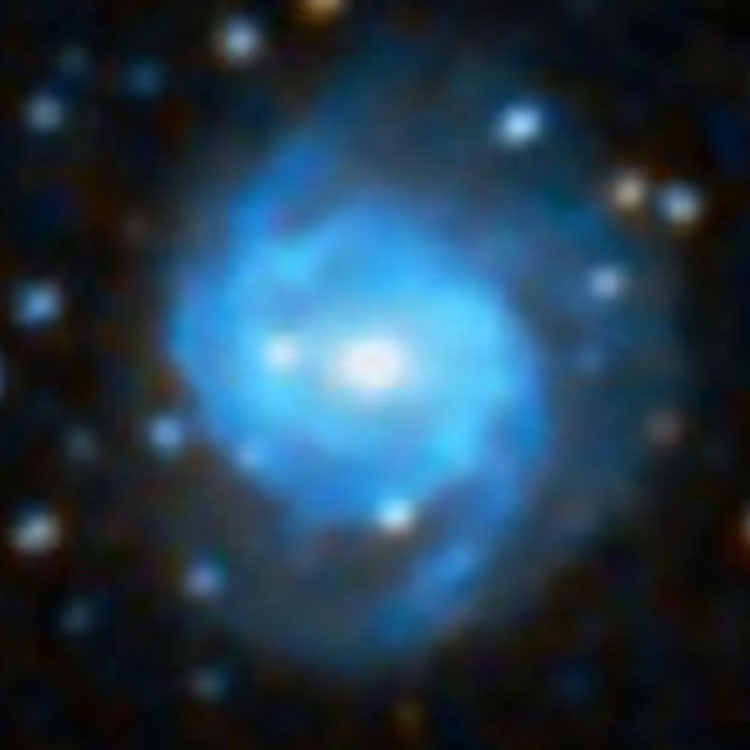
IC 4730 (= PGC 62192)
Discovered (Jul 20, 1901) by DeLisle Stewart
A magnitude 13.2 spiral galaxy (type SB0(rs)a?) in Pavo (RA 18 38 50.3, Dec -63 21 01)
Historical Identification: Per Dreyer, IC 4730 (= DeLisle Stewart #482, 1860 RA 18 25 23, NPD 153 28) is "most extremely faint, extremely small, extremely extended 0°, 9th magnitude star 2 arcmin south". The position precesses to RA 18 38 43.5, Dec -63 21 29, less than an arcmin southwest of the galaxy listed above, the description fits reasonably well, and the sar to the south makes the identification certain.
Physical Information: Apparent size 1.85 by 0.65 arcmin.
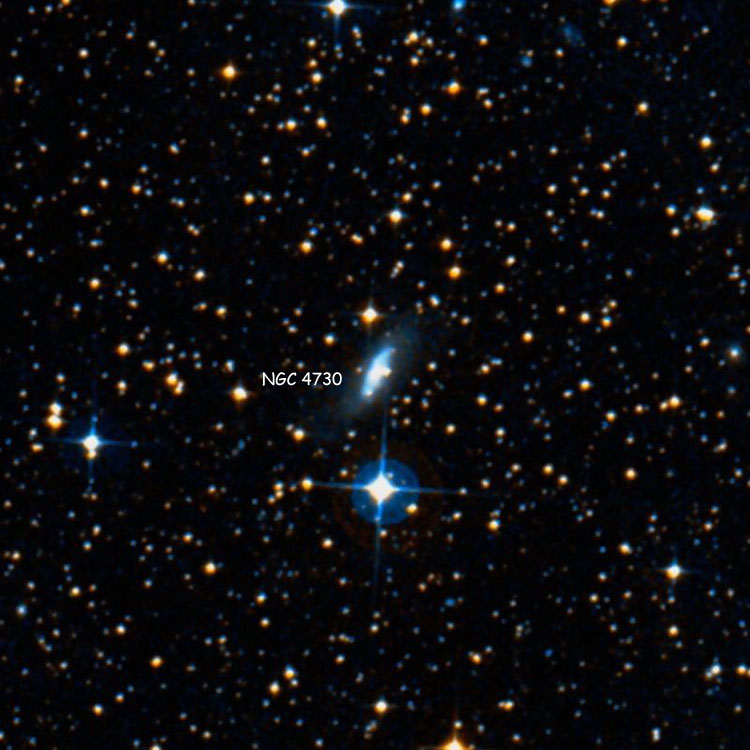
Above, a 12 arcmin wide DSS image centered on IC 4730
Below, a 2.0 arcmin wide DSS image of the galaxy

IC 4731 (= PGC 62187)
Discovered (Jul 20, 1901) by DeLisle Stewart
A magnitude 11.4 lenticular galaxy (type SB0(r)/a?) in Pavo (RA 18 38 42.8, Dec -62 56 36)
Historical Identification: Per Dreyer, IC 4731 (= DeLisle Stewart #481, 1860 RA 18 25 25, NPD 153 03) is "very faint, very small, extremely extended 88°, stellar nucleus". The position precesses to RA 18 38 38.9, Dec -62 56 29, right on the galaxy listed above, the description fits, and there is nothing else nearby, so the identification is certain.
Physical Information: Apparent size 1.9 by 0.95 arcmin.

Above, a 12 arcmin wide DSS image centered on IC 4731
Below, a 2.4 arcmin wide DSS image of the galaxy
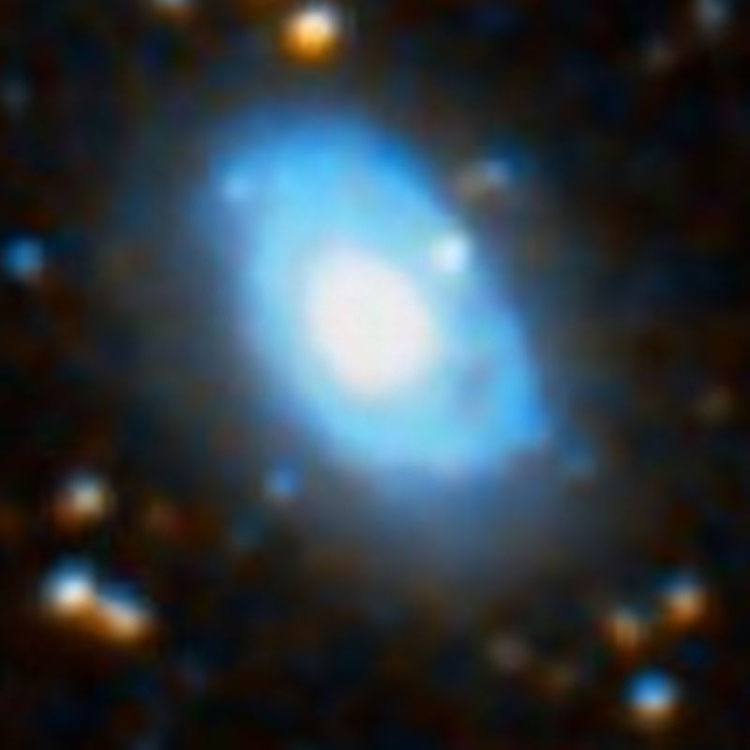
IC 4732
Discovered (1901) by Williamina Fleming
A magnitude 12.1 planetary nebula in Sagittarius (RA 18 33 54.7, Dec -22 38 41)
Historical Identification: Per Dreyer, IC 4732 (= Fleming #99, 1860 RA 18 25 29, NPD 112 45) is "planetary, stellar". The position precesses to RA 18 33 56.9, Dec -22 38 57, about 0.6 arcmin southeast of the planetary nebula listed above, and there is no similar object nearby, so the identification is certain.
Physical Information: Apparent size 7 arcsec for fainter outer regions, 3 arcsec for brighter inner region.

Above, a 12 arcmin wide DSS image centered on IC 4732
Below, a 20 arcsec wide HST image of the planetary nebula (Hubble Legacy Archive; processing Courtney Seligman)

IC 4733
Recorded (Aug 15, 1892) by Guillaume Bigourdan
A magnitude 14.6 star in Draco (RA 18 26 38.2, Dec +64 58 01)
Historical Identification: Per Dreyer, IC 4733 (= Bigourdan #331, 1860 RA 18 26 00, NPD 25 07) is "very faint, stellar". The position precesses to RA 18 26 33.1, Dec +64 58 21, about 0.6 arcmin northwest of the star listed above (so Bigourdan was right about its being "stellar"). Per Corwin, Bigourdan noted the presence of a wide double star to the northeast, so the pair of stars northeast of the star in question makes the identification certain.
Physical Information: I noticed a question about whether this might be a compact galaxy. The object has a measurable proper motion, something no galaxy has, so it is definitely a star.
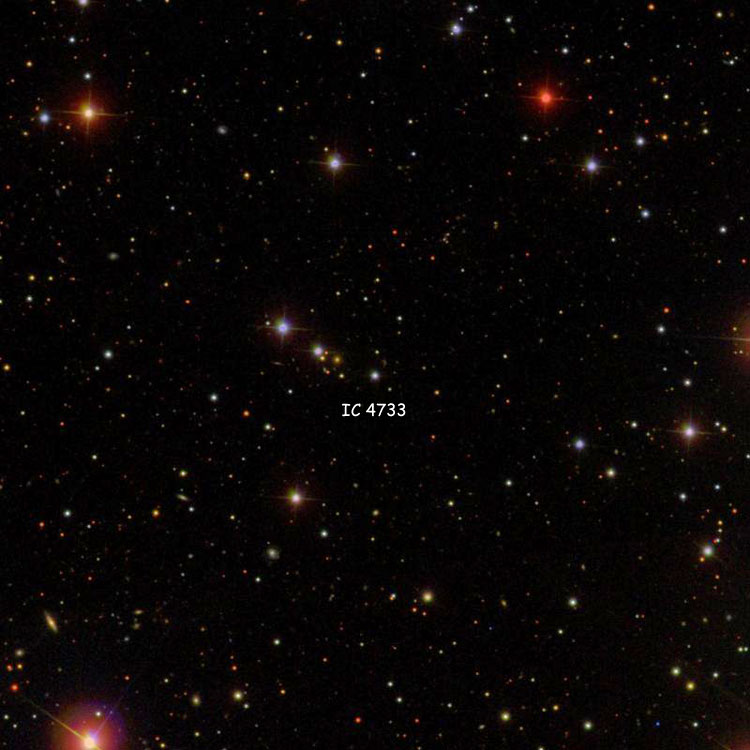
Above, a 12 arcmin wide SDSS image centered on IC 4733
IC 4734 (= PGC 62175)
Discovered (Sep 14, 1901) by DeLisle Stewart
A magnitude 13.2 spiral galaxy (type (R')SB(s)ab pec?) in Pavo (RA 18 38 25.4, Dec -57 29 26)
Historical Identification: Per Dreyer, IC 4734 (= DeLisle Stewart #484, 1860 RA 18 26 22, NPD 147 36) is "very faint, very small, a little extended 130°". The position precesses to RA 18 38 23.6, Dec -57 29 25, right on the galaxy listed above, and although the galaxy as a whole is extended east-west, the bright bar fits the description, so the identification is certain.
Physical Information: Apparent size 1.55 by 0.85 arcmin.

Above, a 12 arcmin wide DSS image centered on IC 4734
Below, a 1.8 arcmin wide DSS image of the galaxy
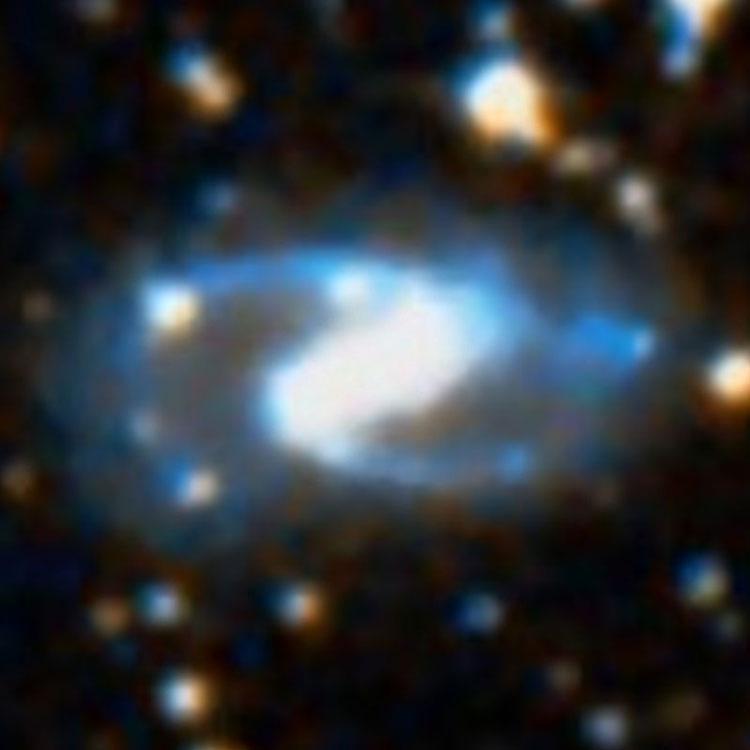
IC 4735 (= PGC 62213)
Discovered (Jul 20, 1901) by DeLisle Stewart
A magnitude 14.6 spiral galaxy (type Sc?) in Pavo (RA 18 39 49.8, Dec -62 57 22)
Historical Identification: Per Dreyer, IC 4735 (= DeLisle Stewart #486, 1860 RA 18 26 31, NPD 153 04) is "extremely faint, very small, brighter middle". The position precesses to RA 18 39 44.9, Dec -62 57 16, only half an arcmin west of the galaxy listed above, and there is nothing else nearby, so the identification is certain.
Physical Information: Apparent size 0.85 by 0.6 arcmin.
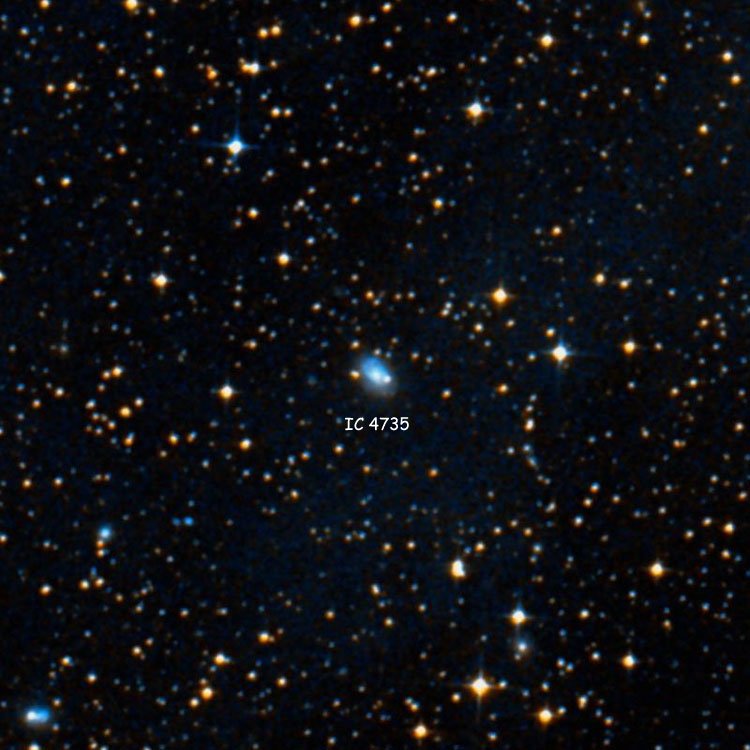
Above, a 12 arcmin wide DSS image centered on IC 4735
Below, a 1.0 arcmin wide DSS image of the galaxy
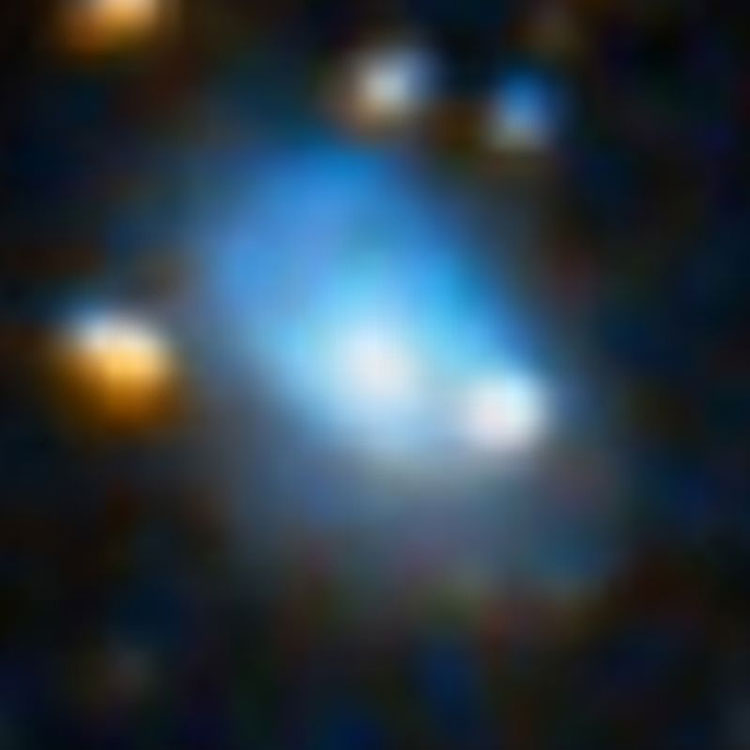
IC 4736 (= PGC 62181)
Discovered (Sep 14, 1901) by DeLisle Stewart
A magnitude 13.9 spiral galaxy (type SAB(s)dm?) in Pavo (RA 18 38 39.7, Dec -57 53 35)
Historical Identification: Per Dreyer, IC 4736 (= DeLisle Stewart #485, 1860 RA 18 26 32, NPD 148 00) is "extremely faint, extremely small, round". The position precesses to RA 18 38 38.1, Dec -57 53 22, right on the galaxy listed above, and there is nothing else nearby, so the identification is certain.
Physical Information: Apparent size 1.45 by 1.05 arcmin.
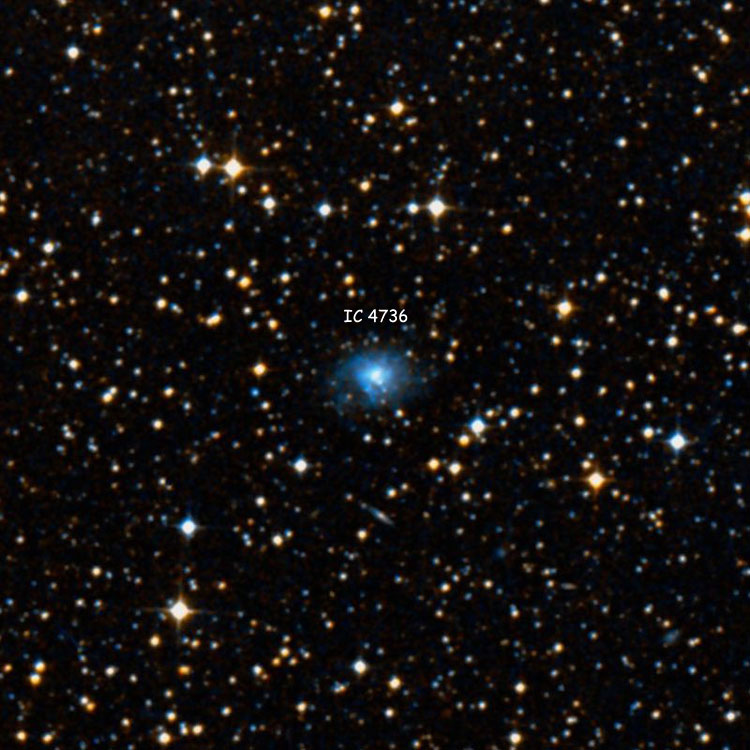
Above, a 12 arcmin wide DSS image centered on IC 4736
Below, a 2.0 arcmin wide DSS image of the galaxy

IC 4737 (= PGC 62222)
Discovered (Jul 20, 1901) by DeLisle Stewart
A magnitude 14.1 spiral galaxy (type (R')SB(s)a?) in Pavo (RA 18 39 58.4, Dec -62 35 53)
Historical Identification: Per Dreyer, IC 4737 (= DeLisle Stewart #487, 1860 RA 18 26 44, NPD 152 43) is "extremely faint, very small, considerably extended 10°, between 2 faint stars". The position precesses to RA 18 39 52.4, Dec -62 36 14, only 0.8 arcmin southwest of the galaxy listed above, the description fits, and there is nothing else nearby, so the identification is certain.
Physical Information: Apparent size 1.0 by 0.75 arcmin.

Above, a 12 arcmin wide DSS image centered on IC 4737
Below, a 1.5 arcmin wide DSS image of the galaxy
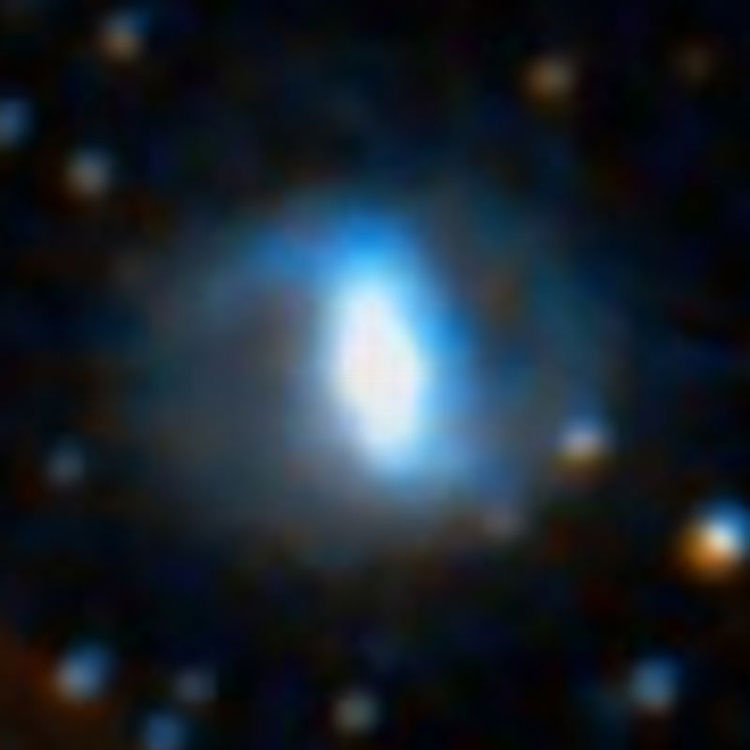
IC 4738 (= PGC 62234)
Discovered (Jul 20, 1901) by DeLisle Stewart
A magnitude 14.6 spiral galaxy (type (R')SA(r)cd?) in Pavo (RA 18 40 26.7, Dec -61 54 08)
Historical Identification: Per Dreyer, IC 4738 (= DeLisle Stewart #488, 1860 RA 18 27 24, NPD 152 01) is "most extremely faint, extremely small, extremely faint star 0.5 arcmin southeast". The position precesses to RA 18 40 21.8, Dec -61 54 07, barely off the western rim of the galaxy listed above, and the star superimposed on its southeastern extension makes the identification certain.
Physical Information: Apparent size 1.2 by 0.7 arcmin.
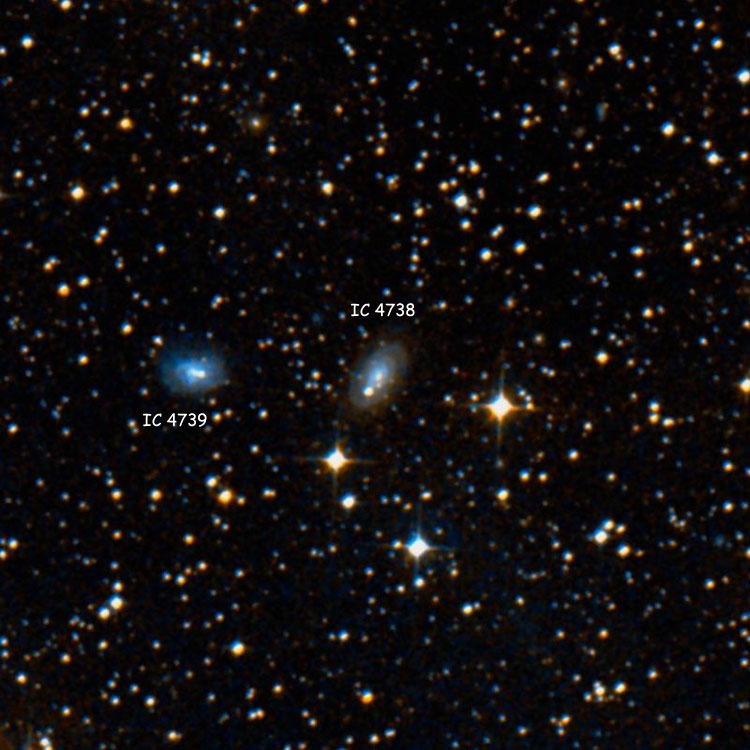
Above, a 12 arcmin wide DSS image centered on IC 4738, also showing IC 4739
Below, a 1.5 arcmin wide DSS image of the galaxy
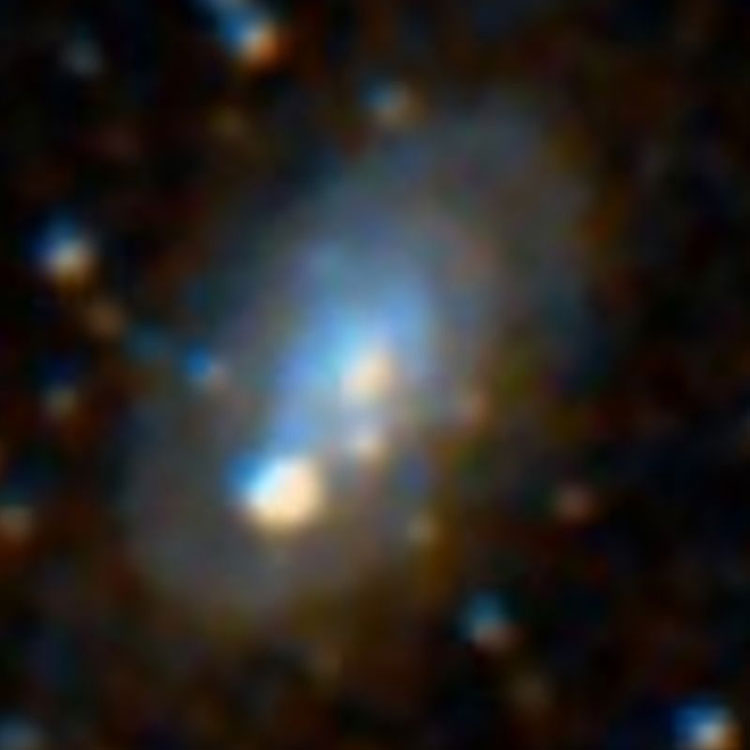
IC 4739 (= PGC 62246)
Discovered (Jul 20, 1901) by DeLisle Stewart
A magnitude 14.4 spiral galaxy (type SABbc?) in Pavo (RA 18 40 51.7, Dec -61 54 04)
Historical Identification: Per Dreyer, IC 4739 (= DeLisle Stewart #489, 1860 RA 18 27 48, NPD 152 01) is "most extremely faint, extremely small, extremely faint star involved". The position precesses to RA 18 40 45.7, Dec -61 54 02, barely off the western rim of the galaxy listed above, and the faint star superimposed on the western side of its nucleus and the consistency of the error in its position with that of nearby IC 4738 make the identification certain.
Physical Information: Apparent size 1.0 by 0.75 arcmin.
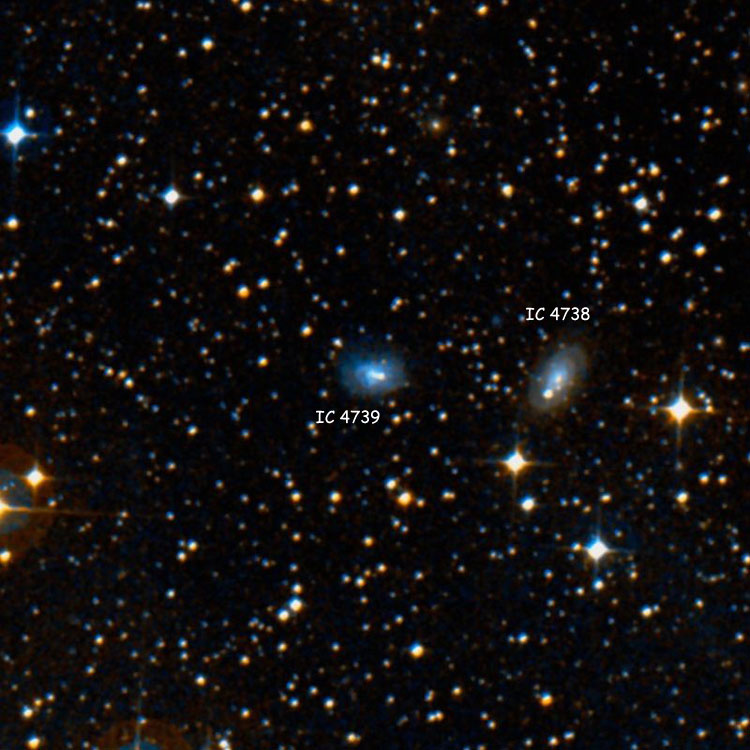
Above, a 12 arcmin wide DSS image centered on IC 4739, also showing IC 4738
Below, a 1.5 arcmin wide DSS image of the galaxy
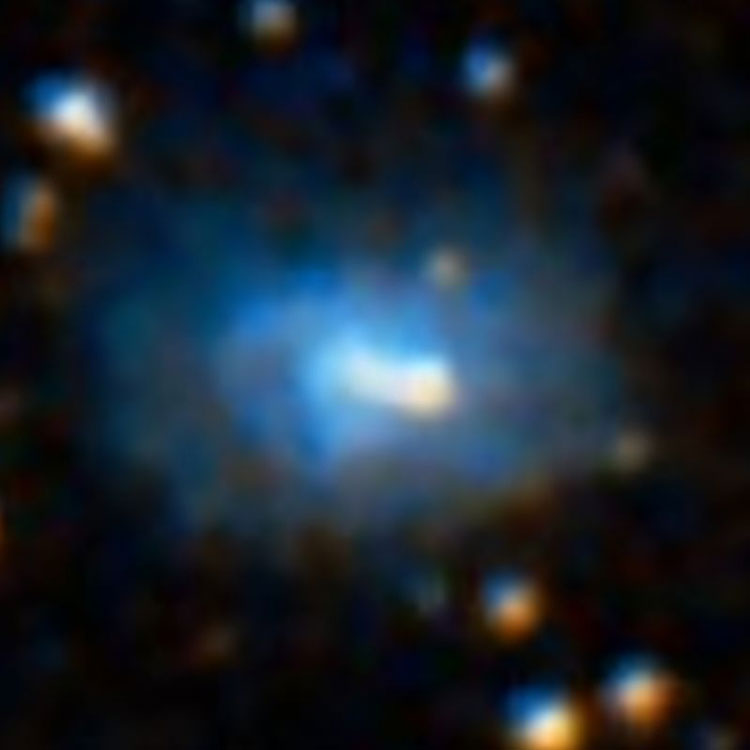
IC 4740 (= PGC 62306)
Discovered (September 1900) by DeLisle Stewart
A magnitude 14.6 spiral galaxy (type SAB(s)c?) in Pavo (RA 18 43 00.4, Dec -68 21 35)
Historical Identification: Per Dreyer, IC 4740 (= DeLisle Stewart #494, 1860 RA 18 28 07, NPD 158 29) is "most extremely faint, very small, round, a little brighter middle, 2 extremely faint stars near". The position precesses to RA 18 43 04.7, Dec -68 21 46, on the southeastern rim of the galaxy listed above, and the nearby starfield confirms the identification.
Physical Information: Apparent size 0.95 by 0.85 arcmin.

Above, a 12 arcmin wide DSS image centered on IC 4740
Below, a 1.2 arcmin wide DSS image of the galaxy

IC 4741 (= PGC 62269)
Discovered (Jul 20, 1901) by DeLisle Stewart
A magnitude 12.6 spiral galaxy (type SA(r)ab?) in Pavo (RA 18 41 43.4, Dec -63 56 53)
Historical Identification: Per Dreyer, IC 4741 (= DeLisle Stewart #490, 1860 RA 18 28 08, NPD 154 04) is "considerably faint, very small, a little extended 20°, stellar nucleus, 4 faint stars involved". The position precesses to RA 18 41 37.6, Dec -63 56 54, just off the western rim of the galaxy listed above and the description fits, so the identification is certain.
Physical Information: Apparent size 1.45 by 1.05 arcmin.
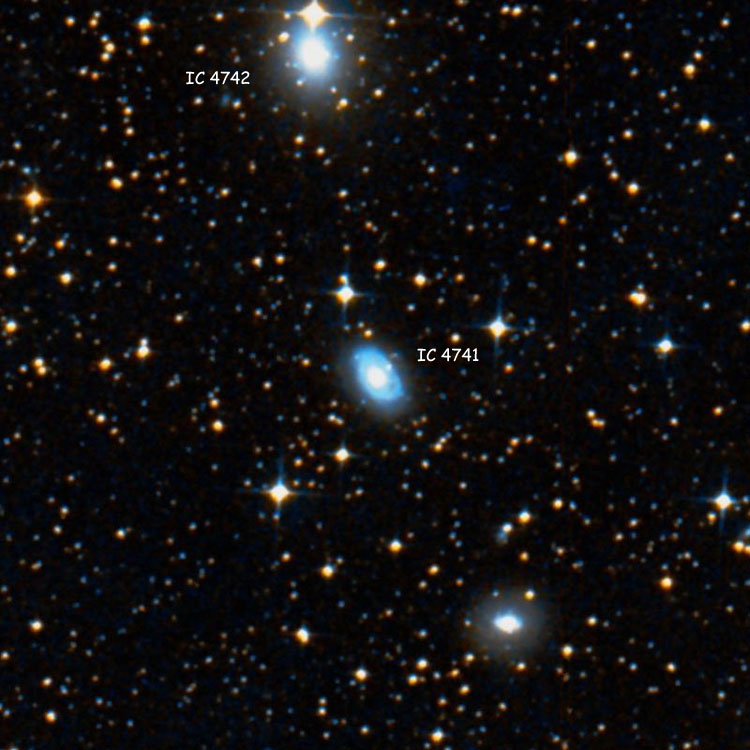
Above, a 12 arcmin wide DSS image centered on IC 4741, also showing IC 4742
Below, a 1.8 arcmin wide DSS image of the galaxy

IC 4742 (= PGC 62270)
Discovered (Jul 20, 1901) by DeLisle Stewart
A magnitude 11.9 elliptical galaxy (type E1?) in Pavo (RA 18 41 52.7, Dec -63 51 42)
Historical Identification: Per Dreyer, IC 4742 (= DeLisle Stewart #492, 1860 RA 18 28 20, NPD 153 59) is "considerably faint, very small, round, brighter middle, faint star involved". The position precesses to RA 18 41 48.2, Dec -63 51 52, right on the galaxy listed above, and the 10th magnitude star on its northern rim makes the identification certain.
Physical Information: Apparent size 2.05 by 1.8 arcmin.
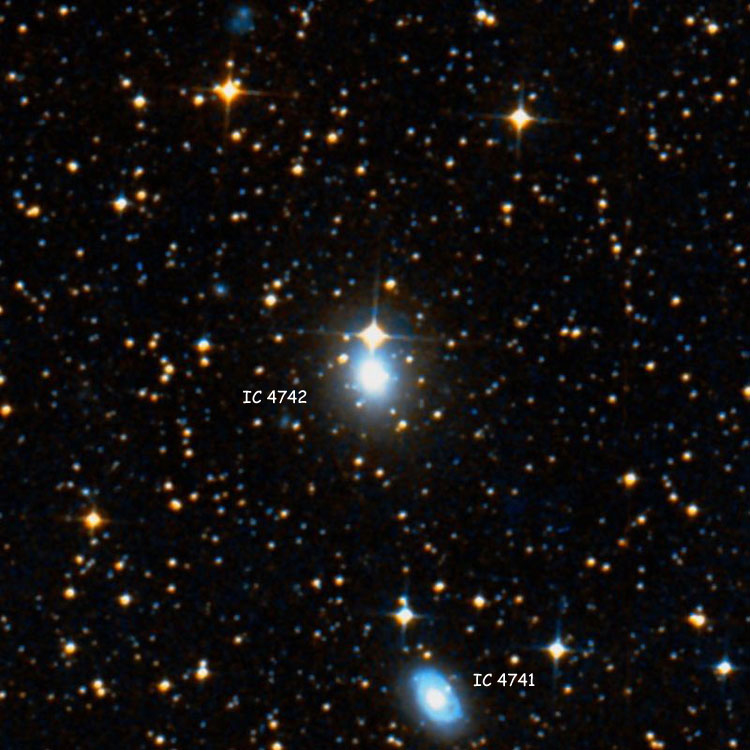
Above, a 12 arcmin wide DSS image centered on IC 4742, also showing IC 4741
Below, a 2.4 arcmin wide DSS image of the galaxy
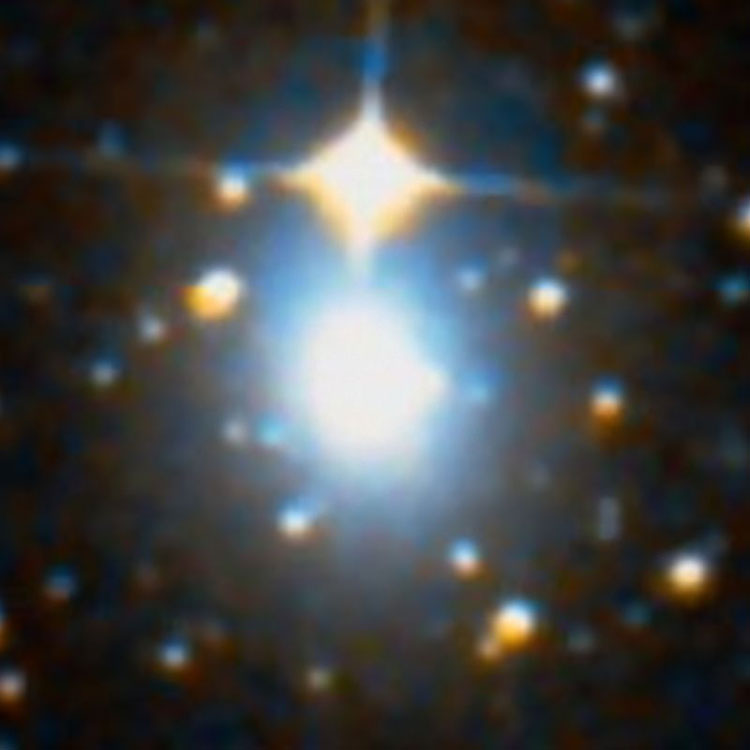
Below, a 2.4 arcmin wide view with brighter star images removed to better show the galaxy
(Image Credit & © Carnegie-Irvine Galaxy Survey; used by permission)
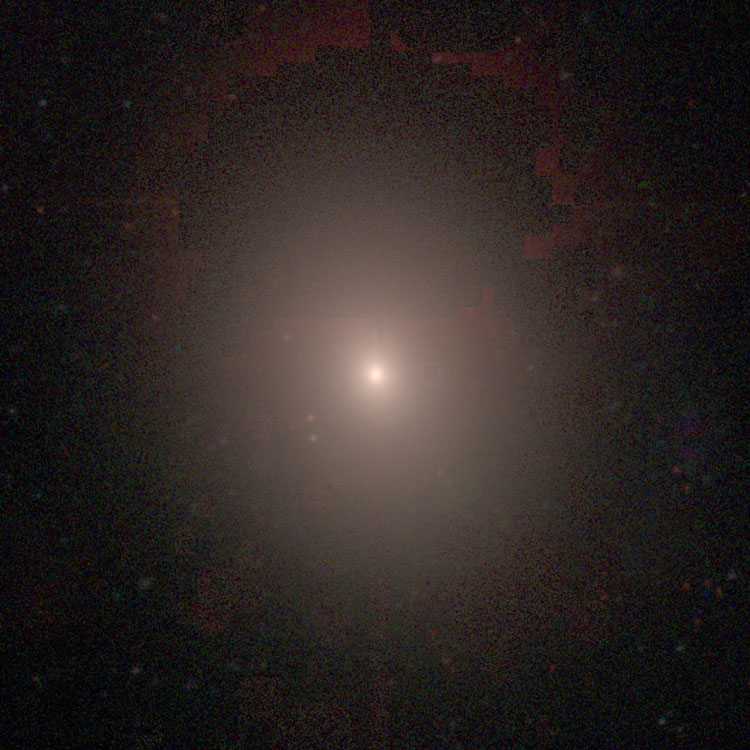
IC 4743 (= PGC 62262)
Discovered (Jul 20, 1901) by DeLisle Stewart
A magnitude 13.7 lenticular galaxy (type S0/a?) in Pavo (RA 18 41 29.0, Dec -61 46 19)
Historical Identification: Per Dreyer, IC 4743 (= DeLisle Stewart #491, 1860 RA 18 28 24, NPD 151 53) is "very faint, brighter middle". The position precesses to RA 18 41 19.6, Dec -61 45 55, about 1.1 arcmin west of the galaxy listed above, and there is nothing else nearby, so the identification is certain.
Physical Information: Apparent size 1.1 by 0.6 arcmin.

Above, a 12 arcmin wide DSS image centered on IC 4743
Below, a 1.5 arcmin wide DSS image of the galaxy

IC 4744 (= PGC 62271)
Discovered (Jul 20, 1901) by DeLisle Stewart
A magnitude 14.5 spiral galaxy (type S pec?) in Pavo (RA 18 41 54.8, Dec -63 13 26)
Historical Identification: Per Dreyer, IC 4744 (= DeLisle Stewart #493, 1860 RA 18 28 30, NPD 153 21) is "most extremely faint, extremely small, round, extremely faint star involved". The position precesses to RA 18 41 47.8, Dec -63 13 51, less than an arcmin west southwest of the galaxy listed above, and the star on its eastern border makes the identification certain.
Physical Information: Apparent size 0.7 by 0.4 arcmin.

Above, a 12 arcmin wide DSS image centered on IC 4744, also showing IC 4749
Below, a 1.0 arcmin wide DSS image of the galaxy
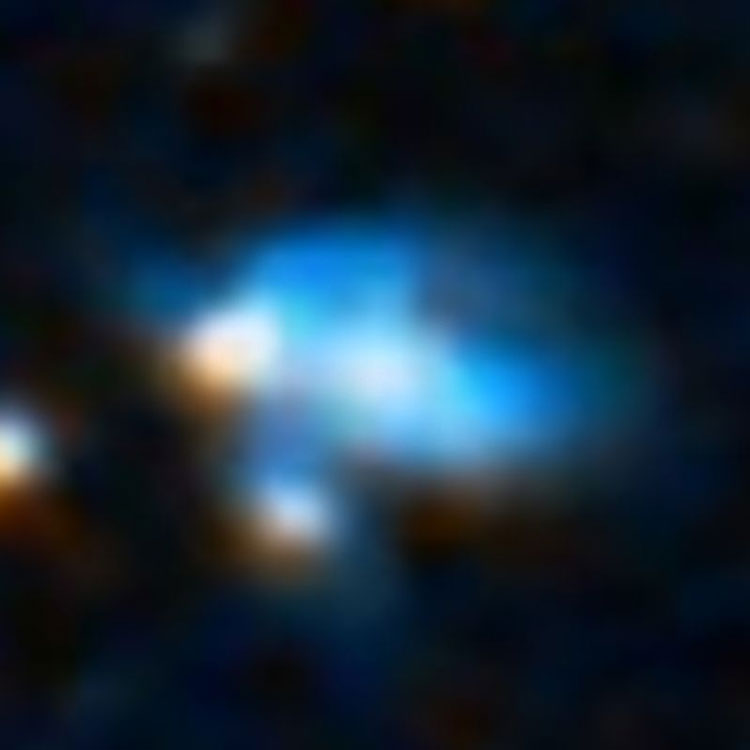
IC 4745 (= PGC 62292)
Discovered (Jul 20, 1901) by DeLisle Stewart
A magnitude 12.7 spiral galaxy (type Sab pec?) in Pavo (RA 18 42 35.6, Dec -64 56 35)
Historical Identification: Per Dreyer, IC 4745 (= DeLisle Stewart #495, 1860 RA 18 28 46, NPD 155 04) is "extremely faint, very small, very faint star 0.4 arcmin west". The position precesses to RA 18 42 32.8, Dec -64 56 45, within the western outline of the galaxy listed above, and the star just west of the nucleus makes the identification certain.
Physical Information: Apparent size 2.9 by 1.1 arcmin.
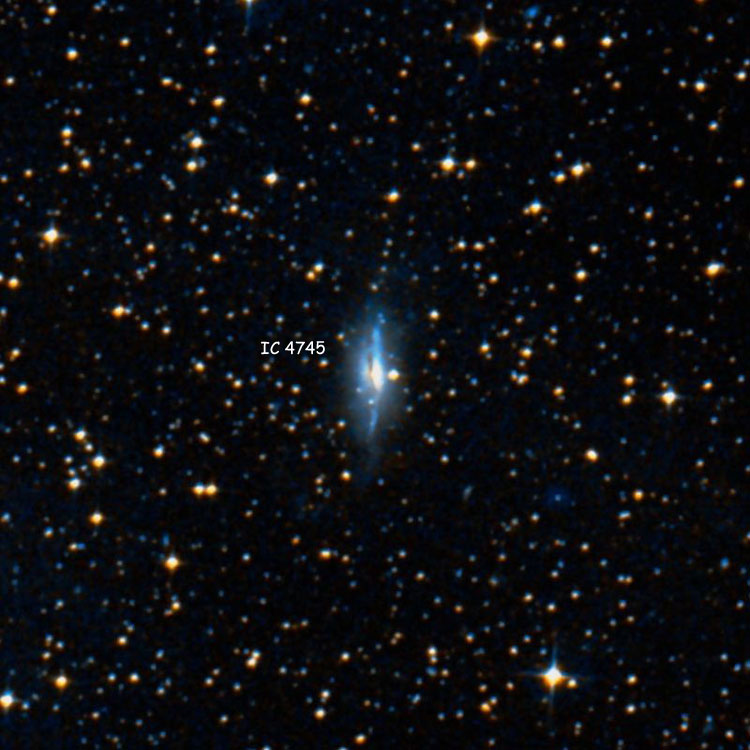
Above, a 12 arcmin wide DSS image centered on IC 4745
Below, a 3.6 arcmin wide DSS image of the galaxy
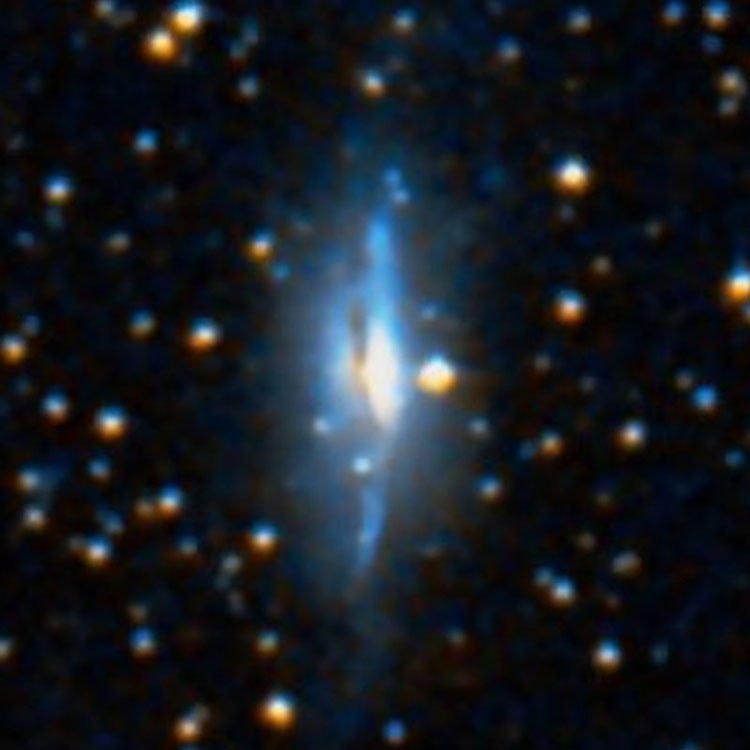
IC 4746 (= PGC 62371)
Discovered (Aug 25, 1900) by DeLisle Stewart
A magnitude 15.2 spiral galaxy (type S pec?) in Pavo (RA 18 45 54.8, Dec -72 40 17)
Historical Identification: Per Dreyer, IC 4746 (= DeLisle Stewart #499, 1860 RA 18 28 48, NPD 162 48) is "extremely faint, extremely small". The position precesses to RA 18 45 52.4, Dec -72 40 25, on the western rim of the galaxy listed above, and there is nothing nearby that could be confused with it, so the identification is certain.
Physical Information: Apparent size 0.5 by 0.4 arcmin.
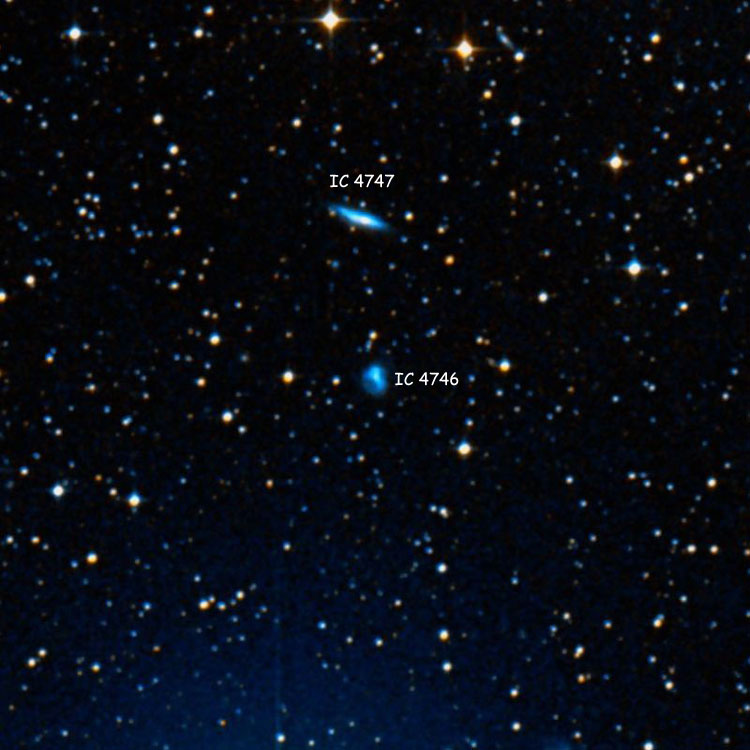
Above, a 12 arcmin wide DSS image centered on IC 4746, also showing IC 4747
Below, a 0.6 arcmin wide DSS image of the galaxy
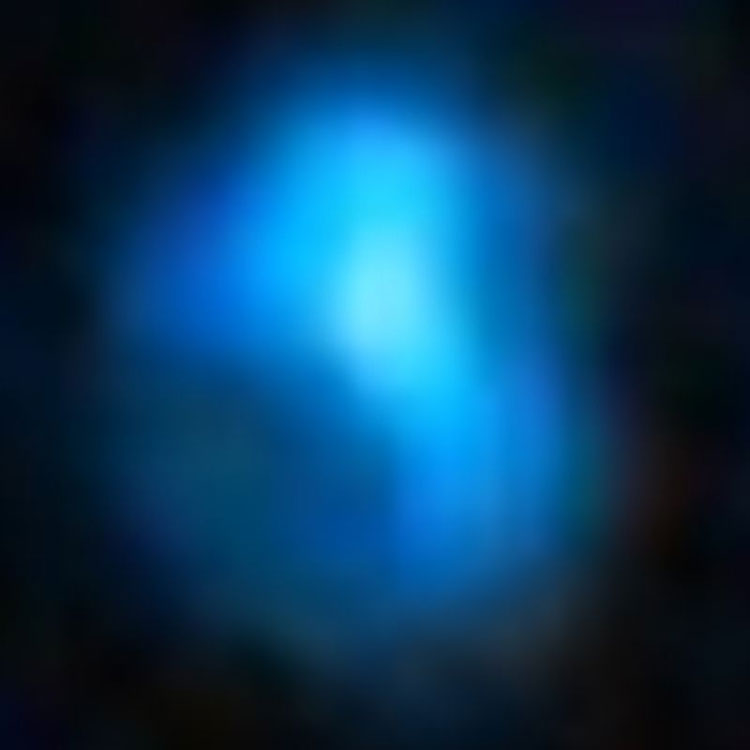
IC 4747 (= PGC 62372)
Discovered (Aug 25, 1900) by DeLisle Stewart
A magnitude 14.1 spiral galaxy (type Sc? pec) in Pavo (RA 18 45 57.3, Dec -72 37 47)
Historical Identification: Per Dreyer, IC 4747 (= DeLisle Stewart #500, 1860 RA 18 28 54, NPD 162 45) is "very faint, extremely small, considerably extended 75°". The position precesses to RA 18 45 56.6, Dec -72 37 24, only 0.4 arcmin north of the galaxy listed above, the description fits, and there is nothing nearby that could be confused with it, so the identification is certain.
Physical Information: Apparent size 1.0 by 0.25 arcmin.
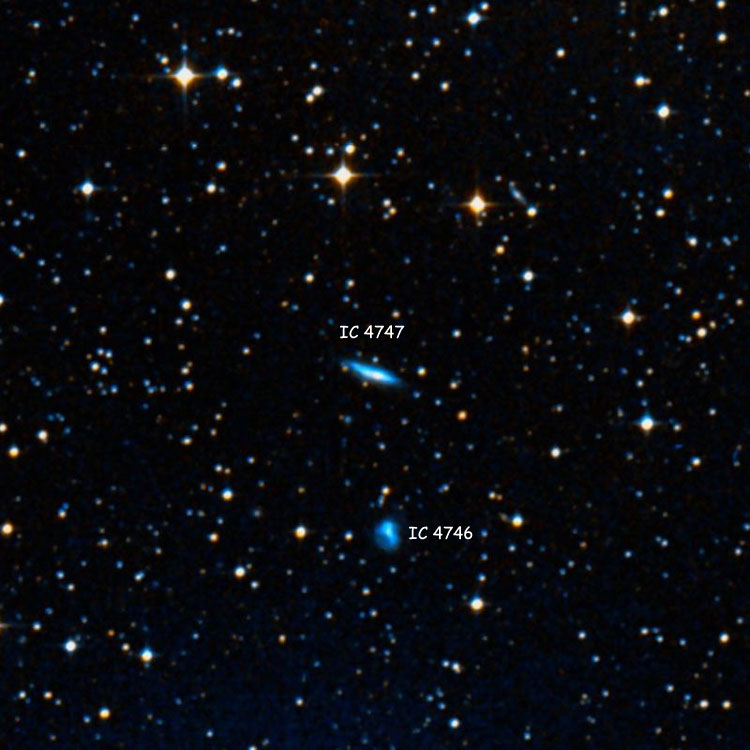
Above, a 12 arcmin wide DSS image centered on IC 4747, also showing IC 4746
Below, a 1.2 arcmin wide DSS image of the galaxy

IC 4748 (= PGC 62299)
Discovered (Jul 20, 1901) by DeLisle Stewart
A magnitude 13.2 lenticular galaxy (type S0?) in Pavo (RA 18 42 45.9, Dec -64 04 22)
Historical Identification: Per Dreyer, IC 4748 (= DeLisle Stewart #496, 1860 RA 18 29 08, NPD 154 12) is "extremely faint, very small, round, faint star 1 arcmin southeast". The position precesses to RA 18 42 39.6, Dec -64 04 42, only 0.75 arcmin west southwest of the galaxy listed above, and the star to its southeast makes the identification certain.
Physical Information: Apparent size 0.95 by 0.9 arcmin.

Above, a 12 arcmin wide DSS image centered on IC 4748
Below, a 1.5 arcmin wide DSS image of the galaxy
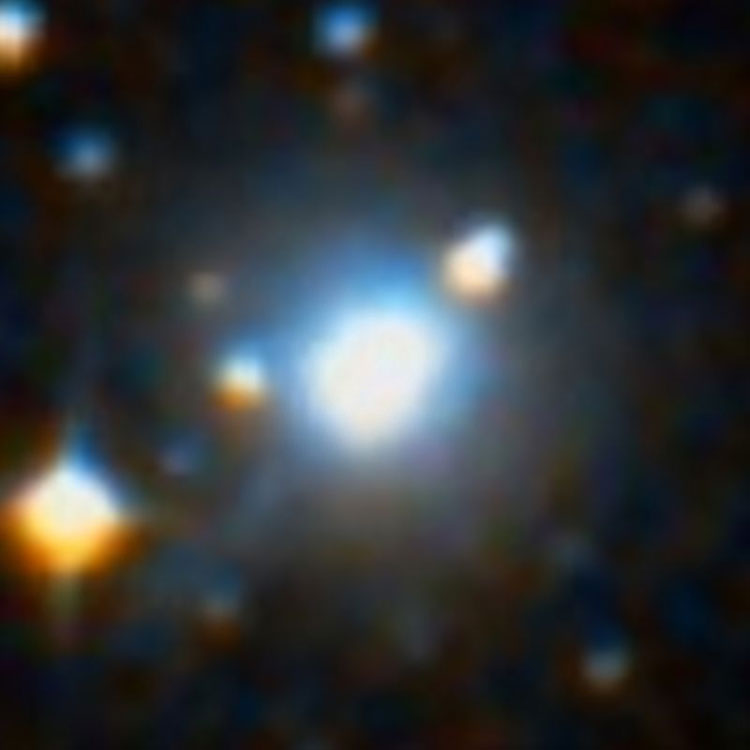
IC 4749 (= PGC 62300)
Discovered (Jul 20, 1901) by DeLisle Stewart
A magnitude 13.1 lenticular galaxy (type S0?) in Pavo (RA 18 42 49.5, Dec -63 12 30)
Historical Identification: Per Dreyer, IC 4749 (= DeLisle Stewart #497, 1860 RA 18 29 36, NPD 153 20) is "most extremely faint, extremely small, 3 faint stars near". The position precesses to RA 18 42 53.2, Dec -63 12 38, within the eastern outline of the galaxy listed above, the description fits, and there is nothing nearby that could be confused with it, so the identification is certain.
Physical Information: Apparent size 1.3 by 1.1 arcmin.
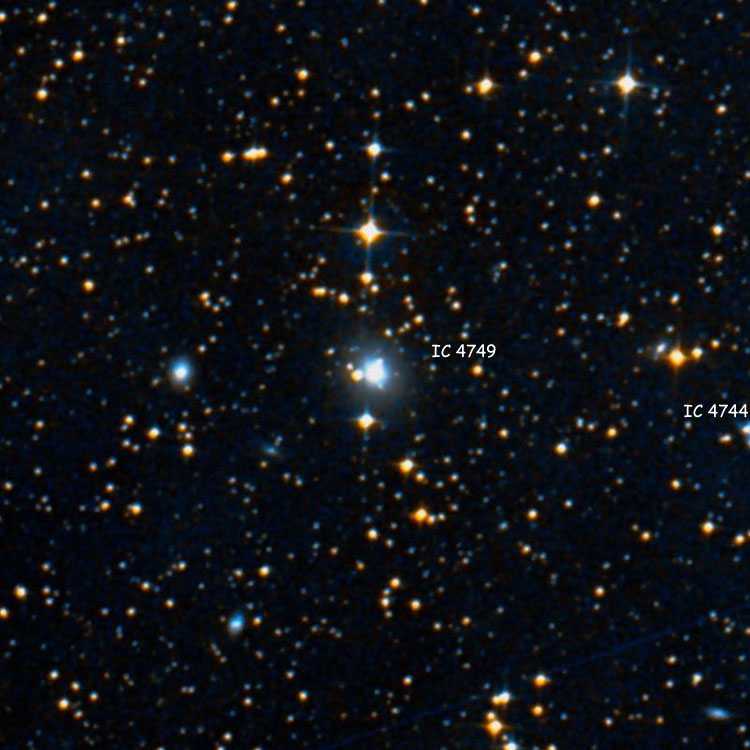
Above, a 12 arcmin wide DSS image centered on IC 4749, almost showing IC 4744
Below, a 1.8 arcmin wide DSS image of the galaxy
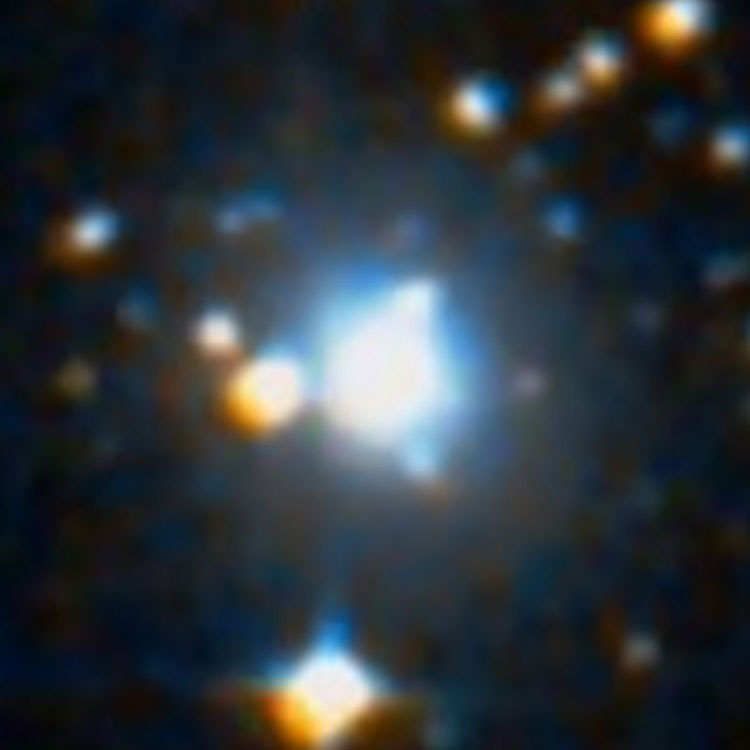
|